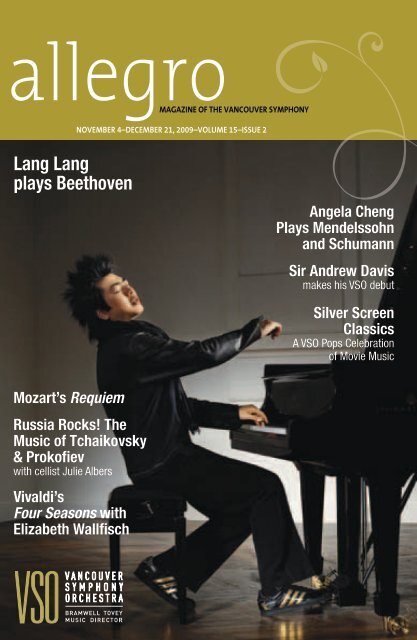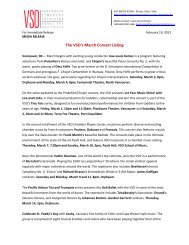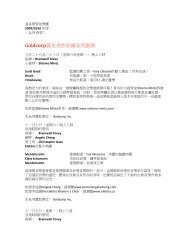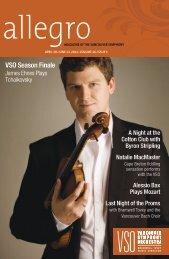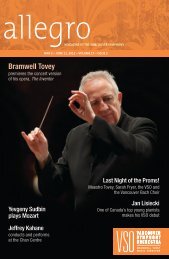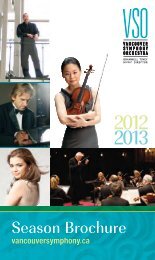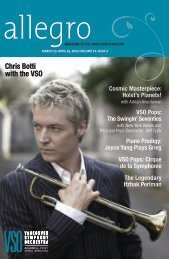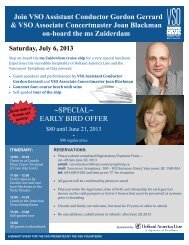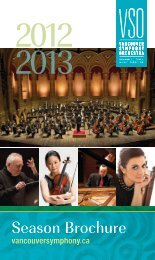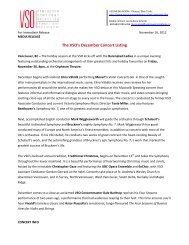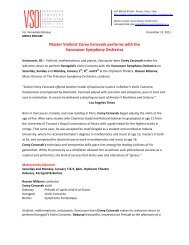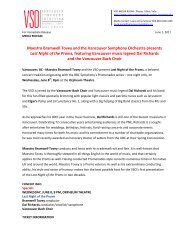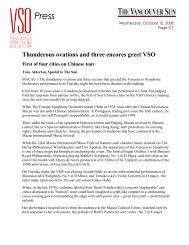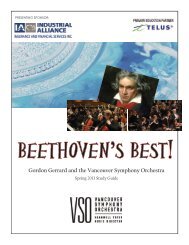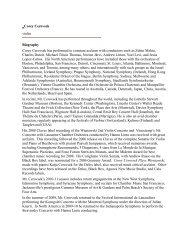Create successful ePaper yourself
Turn your PDF publications into a flip-book with our unique Google optimized e-Paper software.
M E S S A G E F R O Mvso chairman & vso president & CEODear Friends,Thank you for joining us for today’s concert.We are delighted to have you with us.The <strong>Vancouver</strong> <strong>Symphony</strong> <strong>Orchestra</strong>’s2009/2010 Season has already includedmany wonderful performances, but thereis a lot more to come. We invite you to lookthrough this edition of Allegro for upcomingconcerts, or visit our website at www.vancouversymphony.ca to get a completeseason listing and to order your tickets online.In addition to the many evening andmatinee concerts performed by theorchestra, we are proud to present <strong>two</strong>sets of Elementary School Concerts inNovember and April this season. Over400 schools and home school groups fromthroughout the Lower Mainland and as farafield as Nanaimo and Hope will be bringingover 35,000 children to hear the orchestraperform at these weekday morning concerts.The joy and life-enriching experiences theseconcerts bring to students are an importantpart of the VSO’s mission, and we aregrateful to Industrial Alliance Pacific forgenerously sponsoring this series andto TELUS for being our PremierEducation Partner.The VSO maintains eleven distincteducational programs that reach over50,000 children annually. In addition to theElementary School Concerts are the Sundayafternoon Kids Koncerts series sponsored bySpectra Energy. These concerts, for childrenages five to eleven and their families, are botheducational and entertaining in nature.There is still time to subscribe to thisseries and treat your children or grandchildrento the joys of classical music.Another fun way to introduce the family toclassical music is the Tiny Tots series at the<strong>Vancouver</strong> Playhouse in downtown <strong>Vancouver</strong>and the Terry Fox Theatre in Port Coquitlam.These 45-minute performances are designedfor infants to children age five.Coming up December 10 through 19,we are also pleased to present (for the youngat-heart)the VSO’s annual TraditionalChristmas concerts: 14 performances insix locations this season. Performances willtake place in St. Andrew’s Wesley Church indowntown <strong>Vancouver</strong>, Bell Performing ArtsCentre in Surrey, South Delta Baptist Church,Centennial Theatre in North <strong>Vancouver</strong>, theKay Meek Theatre in West <strong>Vancouver</strong> and theMichael J. Fox Theatre in Burnaby.On behalf of the Board of Directors, MaestroTovey, our musicians, staff and volunteers,we thank you for your commitment to theVSO and send all best wishes for theholiday season.Please enjoy the concert!Arthur H. WillmsChair, Board of DirectorsJeff AlexanderPresident & Chief Executive OfficerARTHUR WILLMSJEFF ALEXANDERallegro 7
CherniavskyCherniavsky Laureate ChairThe <strong>Vancouver</strong> <strong>Symphony</strong> <strong>Orchestra</strong> is grateful to Mr. PeterCherniavsky and Mrs. Janey Gudewill for making a major gift tothe <strong>Vancouver</strong> <strong>Symphony</strong> Society in 2002, to create the CherniavskyLaureate Chair in honour of their father, pianist Jan Cherniavsky, andgrandmother, Mrs. B.T. Rogers.Each season, the fund supports the performance of a distinguishedguest pianist. Lang Lang joins us this weekend as the eigth CherniavskyLaureate on one special night with Maestro Bramwell Tovey and the<strong>Orchestra</strong>—November 4 in the Orpheum Theatre.Mrs. Rogers co-founded the VSO in 1919 and served as President ofthe Society for seven years in the early part of the organization’shistory, sustaining it with her financial support and inspirationalleadership. Throughout his life, Jan Cherniavsky performed withthe VSO as soloist on several occasions.The Cherniavsky family’s commitment to the <strong>Vancouver</strong> <strong>Symphony</strong><strong>Orchestra</strong> continues to this day.Mrs. B.T. Rogers (1869–1965),Mr. Jan Cherniavsky (1892–1989)nature found in these wild islands, Felix wroteto his sister (along with the opening phrase ofthe work on the letter) “In order to make youunderstand how extraordinarily the Hebridesaffected me, I send you the following, whichcame into my head there.” Though oftencalled Fingal’s Cave (Mendelssohn actuallytitled it as such on the score, though he usedthe title Hebrides Overture on the orchestralparts) it is more appropriately considered amusical picture of the Hebrides as a whole, asthe composer did not actually visit the large,impressive cave until after writing the music.Very nearly the earliest of Impressionis<strong>two</strong>rks, The Hebrides depicts a mood or“impression” in music, rather than specificallyattempting to depict physical scenes or astory of some kind. The <strong>two</strong> main themes onehears in the overture describe Mendelssohn’sfeelings about his experience in the Hebrides.The first theme is one of awe, power andbeauty, though casting a feeling of isolation—or perhaps a feeling of weakness and humilityin the face of such rugged natural power. Thesecond main theme gives one a feeling of therolling of the sea, and the power and grace ofthe sea’s mighty waves.Mendelssohn’s five symphonies represent anunderrated body of work. The third and fourthof these symphonies were inspired by thetwenty-year old composer’s travels throughEurope. In 1830, after traveling throughScotland and hearing the muse for hisScottish <strong>Symphony</strong>, Mendelssohn sojournedin Italy, where the muse struck again—thusthe <strong>Symphony</strong> No. 4 in A Major ‘Italian’was born. The piece was premiered by theLondon Philharmonic on March 13, 1833,with Mendelssohn conducting.As seems to be the case with manycomposers and their works, Mendelssohnwas not completely satisfied with thepiece—though it received public and criticalacclaim—so he planned revisions; revisionswhich never actually occurred due to his earlydeath at the age of thirty-eight.Mendelssohn’s Mozart-like gift for creatingsublime melodies is obvious throughoutthe piece, no more so than in the firstallegro 11
movement. The Italian <strong>Symphony</strong> sparkleswith Mediterranean exuberance, andbeautiful, memorable melodies. The openingmovement starts the proceedings with ajoyful melody for violins, quickly transitioningto a dashing tune for clarinets and bassoons.The opening theme eventually returns after afew deceptive feints, closing the movementand paving the way for a processionalstylesecond movement of exceedingbeauty, dominated by a Czech hymn and itsvariations, highlighted by an extraordinarypassage for flutes. A minuet highlighted by ahorn-bassoon central section follows, leadinginto a finale in the style of Italian Saltarellodance music.The first theme is for strings, the second forwinds, yielding to a perpetuo tarantella thatmoves inexorably to a strong climax, wherethe opening theme reappears, evolved andstately. This climax gives way to a quiet,melancholy re-examination of the openingmovement, before the first Saltarello themereappears in a powerful and final reiterationto conclude the symphony.Ludwig van BeethovenPiano Concerto No. 2 in B-flat Major, Op. 19b. Bonn, Germany / baptized December 17, 1770d. Vienna, Austria / March 26, 1827Both loved and hated with equal passion atthe turn of the Nineteenth Century in Vienna,Ludwig van Beethoven and his music inspiredemotions and passions as strong and complexas his music itself. Beethoven inspired andintimidated in equal doses as his formidableskills and reputation grew, and as he himselfgrew from a composer who emulated theClassical style of Mozart and Haydn, intothe giant who helped to usher in the “sturmand drang” of the Romantic age. Not only acompositional genius, Beethoven was oneof the great pianists of his time. He wrotefive distinct concerti for piano and orchestra,the concerto performed here tonight beingwritten mainly between 1787 and 1789,though Beethoven tinkered with it over a tenyear period following its initial completion.The Piano Concerto No. 2 in b-flat Majorwas intended as a vehicle for Beethovento begin to make a name for himself inpublic performance as a piano virtuoso. Hein fact made his public performance debutperforming this work in 1795. The concerto,though not one of Beethoven’s favourites,carries a weight and drama to it that is ahallmark of his revolutionary style, despitebeing written very much in the Classical styleof Mozart. One can clearly hear Mozart’sinfluence on Beethoven’s early compositionalstyle, even as Beethoven’s own fledglingmusical personality emerges here andthere—at times with dramatic effect. The solomaterial throughout the concerto is designedto show off Beethoven’s virtuosity, though notat the expense of the overall developmentof the work itself. The second movementespecially demonstrates Beethoven’s famousability to spin delicate, beautiful singingphrases from the pianoforte. Both Mozart’sinfluence and Beethoven’s distinct style areheard the strongest in the final movement, aseries of contrasting episodes and virtuosowriting for the pianist leading to a strong,triumphant, uplifting conclusion. ■Program Notes ©2009 Sophia VincentVANCOUVER SYMPHONY SOCIETYANNUAL GENERAL MEETINGDecember 10, 2009 10:45amDeloitte28th Floor, 1055 Dunsmuir Street, <strong>Vancouver</strong>
NOVEMBER 4–DECEMBER 19, 2009–VOLUME 15–ISSUE 2DECEMBER 27–MARCH 8, 2009–VOLUME 15–ISSUE 3MARCH 13–APRIL 26, 2010–VOLUME 15–ISSUE 4MAY 1–JUNE 14, 2010–VOLUME 15–ISSUE 5allegroSpeak directly to your audienceAdvertise in AllegroALLEGRO DEMOGRAPHICS◆ Affluent◆ Educated◆ Home Owners◆ Culturally Diverse◆ InfluentialALLEGRO FACTS◆ 5 Issues per Season◆ Each Issue Active 2 to 3 Months◆ Read by Over 200,000 PeopleEach YearallegroMAGAZINE OF THE VANCOUVER SYMPHONYallegroMAGAZINE OF THE VANCOUVER SYMPHONYallegroMAGAZINE OF THE VANCOUVER SYMPHONYallegroMAGAZINE OF THE VANCOUVER SYMPHONYLang Langplays BeethovenPiano Concerto No. 2Mozart’s RequiemRussia Rocks! TheMusic of Tchaikovsky& ProkofievWith cellist Julie AlbersVivaldi’sFour Seasons withElizabeth WallfischAngela Chengplays Mendelssohn &A MidsummerNight’s Dream!Sir Andrew Daviswith the VSOA very special eveningwith Celena ShaferDBR / VSOA Voodoo Valentine!VSO Pops: A Tributeto Benny Goodman<strong>Symphony</strong> of a Thousand!Mahler’s <strong>Symphony</strong> No. 8with Measha BrueggergosmanThe Romantic Piano:Fialkowska Plays ChopinJupiter! TheExtraordinary Music ofMozart & RachmaninoffWith Andreas Delfs andLilya ZilbersteinA Little Night Music:Mozart & Haydnwith Jean-Marie Zeitouni andAndrew ArmstrongThe LegendaryItzhak PerlmanCosmicMasterpiece:The Planets!with Adrian AnantawanVSO Pops:The Swingin’ Seventieswith New York Voices andPops Conductor, Jeff TyzikPiano Prodigy:Joyce Yang Plays GriegVSO Pops: Cirquede la SymphonieThe RomanticViolin, withNicola BenedettiBarry Douglasplays BeethovenYevgeny Sudbin:Superstarplays Tchaikovsky’sPiano Concerto No. 1Epic Masterpieces:Rite of Spring andScheherazadeSeason finalewith Bramwell ToveyChris Bottiwith the VSOHighly targeted and highly effective, advertising in Allegro makessense for your business.Contact anna@vancouversymphony.cafor more details and to receive a media kitOrder Your VSO Tickets OnlineEasy, Secure and ConvenientonlineVSO Customer Service or email customerservice@vancouversymphony.caWith the VSO’s new Select Your Own Seat online ticketing system,purchasing your tickets online has never been easier! Set up youronline account so you can easily log in and select your seats, callAlso, sign up for email updates on the VSO website—you will receive periodic emails withupcoming concerts, information, offers and promotions exclusive to email club members.vancouversymphony.caVSO Customer Service 604.876.3434
ANGELA CHENGCHRISTOPHER GAZEbramwell toveyCelebrating the 200th Anniversaryof the births of Felix Mendelssohnand Robert Schumann.CONCERT PROGRAMGOLDCORP MASTERWORKS GOLD / ORPHEUM THEATRE, 8PMsaturday, november 7BELTONE SYMPHONY SUNDAYS / ORPHEUM THEATRE, 2PMsunday, november 8Bramwell Tovey conductor◆ Angela Cheng piano▲ Christopher Gaze actor▲ Elektra Women’s Choir▲▲Gina Morel sopranoLeah Alfred sopranoMENDELSSOHN The Fair Melusine Overture, Op. 32◆ CLARA SCHUMANN Piano Concerto in A minor, Op. 7I. Allegro maestosoII. Romanze: Andante non troppo con graziaIII. Finale: Allegro non troppoIntermission▲ MENDELSSOHN Music from A Midsummer Night’s DreamOverture, Op. 21Incidental Music, Op. 61PRE-CONCERT TALKS free to ticketholders on Saturday evening at 7:05pm,featuring VSO Musicians.CDs AVAILABLE IN THE GIFT SHOP14 allegroMasterworks GOLDSERIES SPONSORSYMPHONY SUNDAYSSERIES SPONSORCBC to Record forSunday Afternoonin Concert
ELEKTRA WOMEN’S CHOIRBramwell Tovey conductorFor a biography of Maestro Tovey pleaserefer to page 9.Angela Cheng pianoConsistently cited for her brilliant technique,tonal beauty and superb musicianship,Angela Cheng is one of Canada’s brighteststars. She has appeared as soloist withvirtually every orchestra in Canada, as wellas many in the US.Angela Cheng’s debut recording of <strong>two</strong>Mozart concerti with Mario Bernardi and theCBC <strong>Vancouver</strong> <strong>Orchestra</strong> received glowingreviews. Other recordings include: for KochInternational, Clara Schumann’s Concerto inA minor with JoAnn Falletta and the Women’sPhilharmonic; for CBC Records, selectedworks of Clara and Robert Schumann, fourSpanish concerti with Hans Graf and theCalgary Philharmonic, and both Shostakovichconcerti with Mario Bernardi and the CBCRadio <strong>Orchestra</strong>. Most recently released wasan all-Chopin recital CD for Universal MusicCanada.Ms. Cheng was the 1986 Gold Medal winnerat the Arthur Rubinstein International PianoMasters Competition, as well as the firstCanadian to win the prestigious MontrealInternational Piano Competition (1988). In thesame year, the Canada Council awarded Ms.Cheng its coveted Career Development Grant.For her outstanding interpretations of Mozart,she received the Medal of Excellence at theMozarteum in Salzburg in 1991.For more information, please visitwww.pianistangelacheng.com.Christopher Gaze actorHost of our Tea & Trumpets series and theChristmas concerts, Christopher Gaze isbest known as Artistic Director of Bard onthe Beach Shakespeare Festival, which hasjust celebrated its 20th season. Born inEngland and trained at the Bristol Old VicTheatre School, Christopher has performedin England, the USA and across Canada,including the Shaw Festival. He came toCanada in 1975 and moved to <strong>Vancouver</strong> in1983. In 1990 he founded Bard on the Beach,which he has nurtured into one of the mostsuccessful not-for-profit arts organizationsin North America.His honours include induction into theBC Entertainment Hall of Fame, Canada’sMeritorious Service Medal, HonoraryDoctorates from UBC and SFU, the BCCommunity Achievement Award, theChildren’s Theatre Foundation of America’sGold Medallion, and a Jessie Award for BestSupporting Actor for Equus at The Playhouse.A gifted public speaker, Christopher frequentlyshares his insights on Shakespeare andtheatre with students, service organizationsand businesses.Elektra Women’s ChoirElektra Women’s Choir was founded byCo-Conductors Morna Edmundson andDiane Loomer, C.M. in 1987 and is regardedas a leader in the classical women’s choirmovement worldwide. Its mandate is toinspire and lead in the choral art formthrough excellence in performance and thecreation, exploration, and celebration ofwomen’s repertoire. Elektra is known for itsadventurous programming, seeking out musicwritten specifically for women and frequentlycommissioning new works. Elektra’s nationaland international appearances includeperformances at the distinguished NationalConvention of the American Choral DirectorsAssociation where the choir gave memorableperformances at Carnegie Hall, RiversideChurch, and Avery Fisher Hall.Elektra was awarded first prize for women’schoirs in four consecutive rounds of theCBC’s National Choral Competition, as well asallegro 15
several major prizes for contemporary musicperformance. The choir is frequently heardon CBC Radio (Canada) and on NPR (UnitedStates). Elektra frequently collaborates withthe CBC, VSO, and Chor Leoni Men’s Choir.The choir released its eighth CD, SacredPlaces, in October 2006; Elektra CDs areavailable through CDBaby.com and iTunesand are in constant demand locally, nationally,and internationally.Felix MendelssohnThe Fair Melusine Overture, Op. 32b. Hamburg, Germany / February 3, 1809d. Leipzig, Germany / November 4, 1847The legend of the mermaid who falls in lovewith a mortal man and tries unsuccessfully tolive among humans is an old and venerableone. Mendelssohn composed this concertoverture on the subject in 1833, fired byan unusual source of inspiration. He hadheard Conradin Kreutzer’s operatic settingof the tale the previous year. “The overturewas encored, but I still disliked it quiteparticularly,” he wrote to his sister Fanny. “Ithen felt a desire to write an overture that,though it might not receive an encore, wouldbe of more real worth.”Because the first performance of his“substitute overture” was scheduled to takeplace in London, where he felt unsure thatlisteners would be familiar with the tale thatinspired it, he initially entitled it Melusine, orthe Mermaid and the Knight. Ignaz Moschelesconducted the première on April 7, 1834.The lukewarm response led Mendelssohn torevise it. He conducted the première of thedefinitive version himself, under the final title,in Leipzig during November 1835. RobertSchumann wrote that it conjures up visionsof “marine abysses full of darting fish withgolden scales, of pearls in open shells, ofburied treasures robbed from men by the sea,of emerald castles towering one above theother.”The overture begins with a lovely, flowingtheme featuring the woodwinds—surely aportrait of the gentle mermaid Melusine andher watery domain. The other primary subjectis an agitated, dramatic theme in the strings,representing the cruel human world andMelusine’s heart-breaking adventures in it.The innocent strength of her theme survivesthe turmoil to close the overture as serenelyas it began.Clara SchumannPiano Concerto in A minor, Op. 7b. Leipzig, Germany / September 13, 1819d. Frankfurt am Mein, Germany / May 20, 1896The daughter of gifted musicians, Clara Wieckreceived a superb musical education in themajor musical centres of Germany. She madeher public debut as a pianist at nine, and hadwon the admiration of prominent musicianssuch as Chopin and Spohr while she was stilla teenager. She and Robert Schumann hadknown each other since childhood.MUSIC LESSONS FROMMEMBERS OF THE VSOMusicians of the <strong>Vancouver</strong> <strong>Symphony</strong> <strong>Orchestra</strong>make up the core faculties of music in many ofthe region’s universities, colleges, academiesand studios.If you are interested in arranging lessonsfor yourself, a child, friend or family member,and would like a referral, please contactLarry Blackman at 604.684.9100 ext. 231or larry@vancouversymphony.ca
They overcame her father’s opposition andwere married in 1840. Robert died 16 yearslater. Clara helped maintain his reputation asa composer, performing his music faithfullyand brilliantly throughout the remainder ofher distinguished international career. Shegave her support to many musicians, FelixMendelssohn, Johannes Brahms and JosephJoachim among them.She was active as a composer from early on.Her principal areas of interest were songsand piano solos. She regularly included thelatter in her own recitals. Apart from a marchcomposed for a friend’s anniversary in 1879,she ceased composing after Robert’s death.Her sole surviving work involving theorchestra was the Concerto in A minor.She composed it between 1833 and 1836,between the ages of fourteen and seventeen.She wrote the finale first, which Robertorchestrated for her. She went on to addthe remaining <strong>two</strong> movements, which shescored herself. The première of the completeconcerto took place in Leipzig on November9, 1835, with the composer as soloist andMendelssohn conducting.As with Mendelssohn’s Piano ConcertoNo. 1, Robert’s first symphony and othercompositions from this era, the movementsof Clara’s concerto are performed withoutpauses between them. The first is boldand dramatic, with contrast provided by alovely, poetic second theme. The secondmovement is a tender Romanze during whichthe orchestra remains silent. It opens withthe piano playing solo, then a cello entersto engage the soloist in an expressive duet.Timpani and brass herald the exultant moodand bracing rhythms of the finale.Felix MendelssohnMusic from A Midsummer Night’sDream, Op. 21 and 61Mendelssohn found himself drawn irresistiblyinto Shakespeare’s colourful world. He maybe said to have reached his musical maturityin 1826, when, just seventeen, he composedhis overture to A Midsummer Night’s Dream.Everyone expressed astonishment that soyoung a man had been able to capture boththe spirit and the diversity of the play soskillfully.Sixteen years later, King Friedrich Wilhelm IVof Prussia commissioned him to write a fullset of incidental music for the play, to be usedat an elaborate German‐language productionin Potsdam. Mendelssohn retained his originaloverture and added twelve new items, someof which used themes from the overture. Thescore is substantial, amounting to about onequarterof the play’s running-time. It includesself-contained preludes and interludes, songs,choruses and brief pieces of underscoringthat are performed together with the text.The play takes place in classical Greece,a time when humans and such legendarycreatures as fairies lived side‐by‐side. Afternumerous complications, <strong>two</strong> pairs of loversat last find happiness with their respectivepartners. They, along with Theseus, Duke ofAthens, and Hippolyta, Queen of the Amazons,are all then joined in marriage at the play’sconclusion. ■Program Notes ©2009 Don Andersonallegro 19
CONCERT PROGRAMbramwell tovey & the vsoSPECIALS / ORPHEUM THEATRE, 7PMsunday, november 820 allegroBramwell Tovey hostA Chamber Music Celebration:The Music of Mendelssohn and SchumannSCHUMANN Three Romances, Op. 94I. Nicht schnellII. Einfach, innigIII. Nicht schnellRoger Cole oboeLinda Lee Thomas pianoSCHUMANN Piano Trio No. 2 in F Major, Op. 80I. Sehr lebhaftII. Mit innigem AusdrückIII. Im mässinger BewegungIV. Nicht zu raschJoan Blackman violinZoltan Rozsnyai celloLinda Lee Thomas pianoIntermissionMENDELSSOHN Octet in E-flat Major, Op. 20I. Allegro moderato, ma con fuocoII. AndanteIII. Scherzo: Allegro leggierissimoIV. PrestoDale Barltrop violinJoan Blackman violinBrent Akins violinJeanette Bernal-Singh violinNeil Miskey violaAndrew Brown violaLee Duckles celloJanet Steinberg cello
DALE BARLTROPROGER COLE LINDA LEE THOMAS JOAN BLACKMANBramwell Tovey hostFor a biography of Maestro Tovey pleaserefer to page 9.Dale Barltrop concertmasterHailing from Brisbane, Australia, Dale Barltrophas performed across North America, Europeand Australia. He served as Principal SecondViolin in the Saint Paul Chamber <strong>Orchestra</strong>for six years prior to his appointment withthe <strong>Vancouver</strong> <strong>Symphony</strong>. During this time,Barltrop appeared regularly as soloist with theSPCO, including a series of baroque concertsunder his direction and a performance of hisown orchestration of Schubert’s Rondo inB minor. In addition to playing the violin,Dale loves to travel and enjoys swimming,running, hiking and skiing.Roger Cole principal oboeWayne and Leslie Ann Ingram ChairRoger Cole has been principal oboist of the<strong>Vancouver</strong> <strong>Symphony</strong> and the former CBCRadio <strong>Orchestra</strong> since 1976. He received hisearly musical training in Seattle, Washingtonand went on to become a scholarshipstudent at Yale University and The JuilliardSchool where he studied with the renownedAmerican oboist, Robert Bloom. He performsregularly in solo and chamber music recitalsand has appeared as soloist with the VSO andthe CBC <strong>Vancouver</strong> <strong>Orchestra</strong> many times.He has recorded a CD for CBC Recordsentitled The Expressive Oboe.Linda Lee Thomasprincipal pianoCarter (Family) Deux Mille Fourndation ChairLinda Lee Thomas has been Principal Pianistof the <strong>Vancouver</strong> <strong>Symphony</strong> <strong>Orchestra</strong>and the former CBC Radio <strong>Orchestra</strong> since1972. As “Chamber Musician Supreme,”she was Artistic Director of MasterpieceMusic, the <strong>Vancouver</strong> East Cultural Centre’shugely successful chamber music series, forseventeen years. In 2000, she was inductedinto the B.C. Entertainment Hall of Fame forher outstanding contributions to the industry.Linda’s other passion is the music anddance of Argentina—the Tango. Since herbold emergence onto the international tangoscene, she has become Canada’s foremosttango musician.Joan Blackman violinJoan Blackman, Associate Concertmaster ofthe VSO, enjoys a vibrant musical life in ourcommunity. Besides playing in the <strong>Orchestra</strong>,she is sought after as a first-class chambermusician in Canada. She is also an activeteacher, giving master classes throughoutBC. Joan has performed and recorded assoloist with <strong>Vancouver</strong> <strong>Symphony</strong>, Victoria<strong>Symphony</strong>, CBC Radio <strong>Orchestra</strong>, and BanffFestival <strong>Orchestra</strong>. As Artistic Director of theVetta Chamber Music and Recital Society, sheprograms and performs in a first-classconcert series of the best in chamber music.www.vettachambermusic.comallegro 21
ZOLTAN ROZSNYAIBRENT AKINSJeanette Bernal-SinghZoltan Rozsnyaiassistant principal celloZoltan Rozsnyai was born into a musicalfamily. Both his parents and grandparentswere professional musicians. He studiedpiano and violin, before taking up the celloat the age of six. He joined the Windsor<strong>Symphony</strong> at fifteen, then left to attend theUniversity of Toronto <strong>two</strong> years later. In 1999he joined the <strong>Vancouver</strong> <strong>Symphony</strong> <strong>Orchestra</strong>,and has been the Assistant Principal Cellistsince 2001. Zoltan maintains an active andvaried musical life in <strong>Vancouver</strong>, and liveswith his wife and <strong>two</strong> young children.Brent Akinsprincipal second violinMr. Akins earned his Bachelor of Music/Performance degree at the University ofSouthern California, under Eudice Shapiro,violin, and Milton Thomas, viola. Beforecoming to <strong>Vancouver</strong>, Mr. Akins was amember of the Los Angeles Chamber<strong>Orchestra</strong> under Sir Neville Mariner, andwas Assistant Principal Second Violin ofthe St. Louis <strong>Symphony</strong>, Leonard Slatkin,conductor. As a co-founder of Notes ofCompassion: <strong>Symphony</strong> Musicians ReachingOut, he is involved in numerous benefitconcerts throughout the <strong>Vancouver</strong> area.Jeanette Bernal-Singh violinJeanette Bernal-Singh, Assistant PrincipalSecond Violin of the <strong>Vancouver</strong> <strong>Symphony</strong>,was born in Mexico and began her violinstudies at the age of three with her motherJoan King and step-father, Pablo Diemecke.Jeanette has won many national andinternational awards and competitions.She holds a master’s degree, attainedwith honours, from the University of BritishColumbia. Jeanette was prize winner atthe Henryk Szerying InternationalCompetition, where she won the HermiloNovelo Memorial Award.In her spare time, Jeanette is concertmasterof the Orchestre Des Concerts DiemeckeVANCOUVER ACADEMY OF MUSIC S.K. LEE COLLEGE PRESENTS THEACADEMY SYMPHONY ORCHESTRALeslie Dala conductor JINYOU LEE violinSunday, November 29, 2009 7:30 pm Orpheum TheatreProgramOverture to La forza del destino . . . . . . . . . . . . . . . . . . . . . . . . . VerdiViolin Concerto in E minor, Op. 64 . . . . . . . . . . . . . . . . Mendelssohn<strong>Symphony</strong> No. 7 in D minor, Op. 70 . . . . . . . . . . . . . . . . . . . . Dvořák22 allegroTickets: $10.00 General Admission, $6.00 Students & SeniorsAvailable at the Academy office or at the door (604) 734-2301
VSO Flex-PassFor the best in flexibility and savings,choose the VSO Flex-PASS!Bramwell Tovey with the <strong>Vancouver</strong> <strong>Symphony</strong> <strong>Orchestra</strong>4 ticketsfor onlyor8 ticketsfor only$139$238The VSO Flex-Pass is valid for A-Sectionseating, so you are saving more than 50%over single concert prices with the 8-packFlex-Pass! The VSO Flex-Pass allows you tochoose the concerts you want to see, when youwant to see them. And you can decide at thelast minute or book up to 8 weeks in advance—the choice is yours!Arabella Steinbacher Bramwell Tovey Nicola Benedetti Yevgeny Sudbin Rachel Barton Pine Barry Douglas New York VoicesBook online: vancouversymphony.ca/flexor call VSO Customer Service at 604.876.3434Best available seating, some restrictions apply—call for details
CHRISTMAS withthe BACH CHOIRSaturday December 5, 2009Orpheum TheatreSING ALONG MESSIAHSunday December 13, 2009Orpheum TheatreTORONTOMENDELSSOHN CHOIRWednesday February 3, 2010Christ Church CathedralBach’s ST. JOHN PASSIONSaturday March 27, 2010Orpheum TheatreLAST NIGHT of the PROMSFriday May 14, 2010Orpheum TheatreVisit www.vancouverbachchoir.com to WIN f ree TICKETS
NEIL MISKEYANDREW BROWNLEE DUCKLESJANET STEINBERG(Die Mahler Enterprises). She performs Indianmusic, and has been a guest on several TVshows, her most recent appearance beinga segment on Chai Time where she wasinterviewed and featured.Neil Miskey principal violaNeil began his career in <strong>Vancouver</strong> afterwinning first prize in the CBC NationalCompetition. He has appeared as soloist withthe VSO, including performances of Berlioz’sHarold in Italy, Vaughan Williams’ Flos Campi,and Bramwell Tovey’s Viola Concerto.A native of Edmonton, he received musicperformance degrees from the University ofAlberta and the University of Michigan, andhas studied at the Banff Centre. As a recipientof a Canada Council Award, he also spent ayear studying in Germany.Andrew Brownassociate principal violaAndrew James Brown is the AssociatePrincipal Violist of the <strong>Vancouver</strong> <strong>Symphony</strong><strong>Orchestra</strong> and was a member of the CBCRadio <strong>Orchestra</strong> for over eighteen years.An enthusiastic chamber musician, he hasworked extensively with <strong>Vancouver</strong>’s leadingmusical organizations, including the VettaQuartet, Curio, the <strong>Vancouver</strong> New MusicEnsemble and Masterpiece Players. A formermember of the Cincinnati Chamber <strong>Orchestra</strong>,Andrew earned his Bachelor and Master ofMusic degrees at The College Conservatory ofMusic, University of Cincinnati, studying withDonald McInnes, Paul Coletti, Gerald Stanickand Masao Kawasaki.Lee Duckles principal celloNezhat and Hassan Khosrowshahi ChairLee Duckles, Principal Cellist with the<strong>Vancouver</strong> <strong>Symphony</strong> <strong>Orchestra</strong>, grew upin a musical family in Berkeley, California.He received his early training in the SanFrancisco Bay Area where he was exposed tothe live performances and teaching of cellistsPablo Casals, Gregor Piatagorsky, MstislavRostropovich, Pierre Fournier, Janos Starkerand Zara Nelsova, to name a few.Prior to moving to <strong>Vancouver</strong>, he received hisdegree in performance from the Universityof Illinois. He subsequently participated inpost-graduate masterclasses with cellistsRostropovich, Starker, and Harvey Shapiro.Janet Steinbergassociate principal celloOriginally from San Francisco, Janet Steinbergjoined the <strong>Vancouver</strong> <strong>Symphony</strong> <strong>Orchestra</strong> asAssociate Principal Cellist in September 1987.Before this, she was the Assistant PrincipalCellist of the Oakland <strong>Symphony</strong> <strong>Orchestra</strong>and performed frequently as a memberof the San Francisco <strong>Symphony</strong>. An activechamber musician, Janet has performed withnumerous ensembles in <strong>Vancouver</strong> and inthe San Francisco Bay area. Janet studiedcello with esteemed pedagogue EleanoreSchoenfeld at the University of SouthernCalifornia in Los Angeles, where she receivedher Bachelor’s and Master’s degrees in MusicPerformance.allegro 25
Robert SchumannThree Romances for Oboe and Piano, Op. 94b. Zwickau, Germany / June 8, 1810d. Endenich, Germany / July 29, 1856Schumann’s obsessive personality regularlyled him to compose large amounts of musicin a particular genre during certain periodsof time. He composed little but piano musicthroughout his twenties, then devoted 1840almost exclusively to song. The year 1842witnessed an equally intense immersion inchamber music. During that single year hewrote three string quartets, a piano quintetand a piano quartet.The year 1849 witnessed an equally singulardevotion to duos for piano and anotherinstrument: the Adagio and Allegro forhorn; Fantasy Pieces for clarinet; Piecesin Folk Style for cello; and in December,the Three Romances for oboe. Each scoresuits the featured instrument’s personalityperfectly, and forms a valuable entry in itssmall solo repertoire (although Schumanndid indicate that the Romances would alsosound effective on the violin or clarinet). Hisintimate knowledge of the piano ensured thatits contributions to all the duos go far beyondmere accompaniment. All these works aregenuine dialogues between equals.The Three Romances are the most significantsolo oboe works of the nineteenth century. Asthe title implies, they have a fundamentallylyrical character, similar to many ofSchumann’s songs. Only in the somewhatanxious middle section of the second piecedoes the emotional temperature rise, andeven then, only briefly.Robert SchumannPiano Trio No. 2 in F Major, Op. 80b. Zwickau, Germany / June 8, 1810d. Endenich, Germany / July 29, 1856Schumann didn’t devote as concentrated aneffort to music for violin, cello and piano as hedid to other chamber music genres. His firstventure came at the close of the “chambermusic” year, 1842. He had exhausted himselfso completely through the composition of thequartets and quintet mentioned above thatthe creation of a traditional, closely organizedpiano trio lay beyond his grasp. He thus madehis initial foray into the time-honoured genrewith a set of lighter character works: the fourFantasy Pieces, Op. 88.Five years passed after the creation ofthe Fantasy Pieces before he felt himselfprepared to compose full piano trios. Hewrote the first <strong>two</strong> in 1847 and the third in1851. Among the stimuli for the first <strong>two</strong>were the Trio in D minor by his good friendFelix Mendelssohn, which Robert praisedas the master trio of the age. Another camefrom his brilliantly musical wife, Clara, whomhe had married in 1840 after years of fierceopposition from her father. She composed atrio in G minor in 1846. Robert answered hersin June 1847 with the Trio No. 1 in D minor,Op. 63.No. 2 followed quickly, between August andSeptember of the same year. It is muchdifferent in character from its predecessor,making, as Schumann wrote, “a friendlierand more immediate impression.” It containsan intimate autobiographical reference. Thefirst <strong>two</strong> movements quote a phrase fromone of the songs in Leiderkreis (Song Cycle),composed for Clara just before their marriage:“In the depths of my heart, I keep a radiantimage of you.”The opening movement balances robust andromantic elements. Schumann follows it withthe ardent love song of the slow movement,whose main theme is introduced by the violin.The third movement is not a loud, jestingscherzo but a flowing, whimsical intermezzo.Schumann rekindles the opening movement’senergy in the bold, celebratory finale.Felix MendelssohnOctet in E-flat Major, Op. 20b. Hamburg, Germany / February 3, 1809d. Leipzig, Germany / November 4, 1847Mendelssohn was second only to Mozart inthe ranks of child prodigies. Between theages of twelve and fourteen, he composedthirteen delightful symphonies for strings,26 allegro
and several concerti. The beautifully polishedOctet for Strings (1825) and the magicaloverture to Shakespeare’s romantic comedy,A Midsummer Night’s Dream (1826),announced his full maturity.“The octetet’s texturesregularly display numerousimaginative and intricatecombinations...”The octet is true chamber music, not asymphony in disguise. Each of the eight partsis a separate and indispensable componentof the whole (although Mendelssohn doesgrant the first of the four violins especiallybrilliant status). This sets it apart from thesimilarly scored but conceptually differentseries of double quartets that Louis Spohrhad begun to create <strong>two</strong> years earlier. Theoctet’s textures regularly display numerousimaginative and intricate combinations,without ever growing dense or heavy. Theoctet remained Mendelssohn’s own favouriteamong his youthful works.The first movement, the longest of the four,balances energy and warmth. A melancholyandante follows, the principal theme cast inthe lilting style of a siciliano. Mendelssohntold his sister Fanny that the exhilaratingscherzo was inspired by astanza from Goethe’s Faust:Trails of cloud and mist brighten from above;Breeze in the foliage and wind in the reeds –And everything is scattered.Fanny wrote of it, “Everything is new,strange, yet so attractive, so sympathetic.One feels so close to the spirit world, solightly drawn up into the sky, one mighteven wish for a broomstick, the better tofollow the mischievous host.” A finale thatoutshines the previous movements fortextural ingenuity and sheer exuberanceconcludes the octet. ■Program Notes ©2009 Don Anderson
angelachengbramwell toveyCelebrating the 200th Anniversaryof the births of Felix Mendelssohnand Robert Schumann.CONCERT PROGRAMGOLDCORP MASTERWORKS GOLD / ORPHEUM THEATRE, 8PMmonday, november 9Bramwell Tovey conductor◆ Angela Cheng pianoFANNY MENDELSSOHN Overture in C Major◆ MENDELSSOHN Piano Concerto No. 1 in G minor, Op. 25I. Molto allegro con fuocoII. AndanteIII. Presto: Molto allegro e vivaceIntermissionSCHUMANN <strong>Symphony</strong> No. 4 in D minor, Op. 120I. Ziemlich langsam—LebhaftII. Romanze: Ziemlich langsamIII. Scherzo: LebhaftIV. Langsam—LebhaftPRE-CONCERT TALKS free to ticketholders at 7:05pm, featuring VSO Musicians.CDs AVAILABLE IN THE GIFT SHOP28 allegroMasterworks GOLDSERIES SPONSORCBC to Record forSunday Afternoonin Concert
Bramwell Tovey conductorFor a biography of Maestro Tovey pleaserefer to page 9.Angela Cheng pianoFor a biography of Angela Cheng pleaserefer to page 15.Fanny MendelssohnOverture in C Majorb. Hamburg, Germany / November 14, 1805d. Berlin, Germany / May 14, 1847Many who knew Felix’s much-beloved oldersister believed her to be as musically giftedas he. However the social values of the day—women were not encouraged to followprofessional careers—meant that her talentrarely received opportunities to present itself,much less to grow. She selflessly served herfamous brother as mentor and inspirationthroughout his career. Like Felix she diedyoung, during the same year as he. Ironically,she suffered a stroke while leading a choralrehearsal of his oratorio, The First WalpurgisNight.Only a few of Fanny’s 400 compositions werepublished during her lifetime. This graciousorchestral overture was probably composedaround 1830, for performance (like much ofher music) at the family’s weekly in-homeconcerts in Berlin. It sat gathering dust in theMendelssohn Archive in that city, apparentlysince the composer’s death (if not longer),until Judith Rosen, a board member withthe Women’s Philharmonic of San Francisco,negotiated its release. Reconstructed froma cluttered, much-revised score in thecomposer’s own hand, it was recordedfor the first time in 1992. Opening with anintroduction in slow tempo, it continues witha melodically appealing, transparently-scoredallegro.Felix MendelssohnPiano Concerto No. 1 in G minor, Op. 25b. Hamburg, Germany / February 3, 1809d. Leipzig, Germany / November 4, 1847Mendelssohn spent the years 1830‐1832 ona journey throughout Europe—one concernedwith equal parts furthering his career andsimple pleasure. En route to Italy during thesummer of 1830, he stopped over in Munich.There he met Delphine von Schauroth, a17-year-old pianist with whom he developeda strong mutual attraction. He continued on toRome where, among other musical activities,he sketched this concerto. He completed it onhis return to Munich and dedicated it to hisyoung lady friend.The composer himself appeared as soloist inthe première, which took place during an all-Mendelssohn concert in Munich on October17, 1831. “My concerto was applaudedlong and loud,” he wrote home to his father.“The orchestra accompanied well, and thework itself was truly mad.” As for Delphinevon Schauroth, time and distance graduallydissolved her relationship with Mendelssohn.In many ways, the concerto reflectsMendelssohn’s role as a bridge betweenthe Classical and Romantic eras. On theClassical side, the three movements followfairly traditional models: sonata, song androndo, respectively. But following a practiceinstituted by Beethoven, Mendelssohn directsthat they be performed as a continuouswhole. He did so primarily for artistic reasons,to give the concerto a greater sense of flowand cohesiveness. He had a more practicalgoal in mind as well: to keep audiencesfrom breaking the spell of performance byapplauding before the very end of the piece.The concerto also employs another favouriteRomantic practice, cyclical reference. Thesame brass fanfare introduces both thesecond and third sections, and the finaleincludes a brief quotation from the firstmovement.Robert Schumann<strong>Symphony</strong> No. 4 in D minor, Op. 120b. Zwickau, Germany / June 8, 1810d. Endenich, Germany / July 29, 1856As with his friend Mendelssohn, Schumann’scareer spanned the early heyday ofRomanticism, with its increased expressionof emotion through music, and its searchfor new ways to do so. He and many ofallegro 29
his contemporaries continued to composesymphonies, for example. But each of themalso helped expand the horizons of what asymphony could express, and how it mightachieve that goal.Franz Liszt took extreme steps along thispath of experimentation. He developed thesymphonic poem, a form of music inspired byextra-musical concepts. In order to increaseits cohesiveness and flow, a symphonicpoem is based upon the transformation andinterrelation of a handful of themes.Schumann’s most extreme use of Liszt’smethod came in <strong>Symphony</strong> No. 4. Hecompleted the original version in 1841,just <strong>two</strong> months after the première of<strong>Symphony</strong> No. 1. As with one of Liszt’ssymphonic poems, it is based on a smallgroup of themes. Mirroring Mendelssohn’sPiano Concerto No. 1, he intended to haveit performed as a continuous whole. Heretreated from that approach, however,instructing that only the last <strong>two</strong> movementsbe played without interruption. The indifferentresponse to the première led him to shelvethe symphony.Following the successful launch of <strong>Symphony</strong>No. 3 in February 1851, he felt confidentenough to perform a rescue mission on the<strong>Symphony</strong> in D minor. His revisions includedchanges in orchestration and a strengtheningof the interrelationships between themes. Healso decided to carry through on his originalintention, directing that all four movements beplayed without breaks between them. He alsosettled on calling it <strong>Symphony</strong> No. 4.Virtually all the materials for the entire workappear in the slow, unsettled introductionto the first movement. An urgent allegrofollows. The ensuing romance offers strong,lyrical contrast, dotted with expressivepassages featuring oboe, cello and violin. Thescherzo is a rustic, strongly rhythmic affair.The uncertain mood of the following bridgepassage is resolved by the arrival of theexuberant finale. ■Program Notes ©2009 Don Anderson
CONCERT PROGRAMMASTERWORKS DIAMOND / ORPHEUM THEATRE, 8PMsaturday & monday, november 14, 16Bramwell Tovey conductor◆ Kathleen Brett soprano▲ Elizabeth Turnbull mezzo-soprano◗ Benjamin Butterfield tenor♦ John Relyea baritone✚ <strong>Vancouver</strong> Bach ChoirMOZART The Magic Flute, K. 620:Overture◆ Ach, ich fühl’s, es ist verschwunden◗ Dies Bildnis ist bezaubernd schön♦ O Isis und OsirisMOZART La Clemenza di Tito, K. 621:Overture▲ Parto, ma tu ben mioIntermission✚ MOZART Requiem in D minor, K. 626INTROITUSI. RequiemII. KyrsieSEQUENZIII. Dies iraeIV. Tuba MirumV. Rex TremendaeVI. RecordareVII. ConfutatisVIII. LacrimosaOFFERTORIUMIX. Domine JesuX. HostiasSANCTUSXI. SanctusXII. BenedictusAGNUS DEIXIII. Agnus DeiCOMMUNIOXIV. Lux aeternaPRE-CONCERT TALKS free to ticketholders at 7:05pm, featuring VSO Musicians.CDs AVAILABLE IN THE GIFT SHOP32 allegro
BRAMWELL TOVEYKATHLEEN BRETT ELIZABETH TURNBELL BENJAMIN BUTTERFIELDBramwell Tovey conductorFor a biography of Maestro Tovey pleaserefer to page 9.Kathleen Brett sopranoCanadian soprano Kathleen Brett is cherishedby audiences in America and Europe not onlyfor the beauty of her tone and stylistic instinct,but also for her natural stage presence anddramatic skills. Ms. Brett has performedaround the world, including San Francisco, LosAngeles, Dallas, New York (City Opera), London(Covent Garden) and Antwerp (Vlaamse Opera).Recent engagements include the role of BirdieHubbard in Pacifc Opera Victoria’s acclaimedproduction of Blitzstein’s Regina; Messiah withthe National Arts Centre, Ottawa; and Mozart’sRequiem with the <strong>Vancouver</strong> <strong>Symphony</strong>. Shewas the featured soloist on tour with theBoston Pops and also makes appearanceswith the Cincinnati Pops and the Toronto<strong>Symphony</strong> this season.Elizabeth Turnbull mezzo-sopranoA winner in the Metropolitan Opera NationalCouncil auditions, North American finalist inthe International Bernstein Song and OratorioCompetition, and recipient of a CanadaCouncil Career Development grant, ElizabethTurnbull is a mezzo with a distinguishedreputation in the USA and Canada, hailed bythe press as “(one) of this country’s finestyoung singers, luminous and rich-voiced.”Recent season highlights include the worldpremière of Filumena for the Calgary Opera,playing the role of Maria. She was Ulricain Un Ballo in Maschera for Opera Lyra inOttawa and other recent engagementsinclude Madame de la Croissy in Dialoguesdes Carmélites for Calgary Opera, Juno inHandel’s Semele for Chicago Opera Theater,Larina in Eugene Onegin for Opera Ontario,and the title role in Carmen for EdmontonOpera.Ms. Turnbull recorded Haydn’sHarmoniemesse and Mozart’s LitaniaeLauretanae with Rilling and the <strong>Vancouver</strong>Cantata Singers. Further credits include theGuelph Spring Festival, New Music ConcertSeries, the Elora Festival, and the worldpremière of Victor Davies’ Revelation withBramwell Tovey and the Winnipeg <strong>Symphony</strong>.Benjamin Butterfield tenorBenjamin Butterfield’s opera credits includeArizona (Don Giovanni), Toulouse (Mignon),Toronto (Cunning Little Vixen), <strong>Vancouver</strong>(Rake’s Progress) and Victoria (Semele) aswell as touring with the New York City Opera(Die Zauberflöte), Welsh National Opera(Barber of Seville), the San Carlo in Naples(Persephone), Canterbury Opera, New Zealand(Eugene Onegin) and with Opera Atelier (Didoand Aeneas).Recent performances have includedMessiaen’s St. Francois d’Assise with KentNagano in Montreal and Magic Flute withBernard Labadie in Toronto.Mr. Butterfield has recorded for CBC, Koch,Dorion, Marquis, Timpani and Musicaleopolis,and he is head of voice at the University ofVictoria in British Columbia.allegro 33
JOHN RELYEAVANCOUVER BACH CHOIRJohn Relyea baritoneJohn Relyea continues to distinguish himselfas one of today’s finest bass-baritones.Mr. Relyea has appeared in many of theworld’s most celebrated opera housesincluding the Metropolitan Opera, SanFrancisco Opera (where he is an alumnus ofthe Merola Opera Program and a former AdlerFellow), Seattle Opera, Royal Opera HouseCovent Garden, Paris Opera, Munich StateOpera, and the Vienna State Opera. His rolesinclude Figaro in Le Nozze di Figaro, the FourVillains in Les contes de Hoffman, Raimondoin Lucia di Lammermoor, Giorgio in I Puritani,Escamillo in Carmen, Don Basilio in Il barbieredi Siviglia, Colline in La Bohème, Marke inTristan und Isolde, Caspar in Der Freischutz,the title role in Bluebeard’s Castle, Banquo inMacbeth, Collatinus in The Rape of Lucretiaand Garibaldo in Rodelinda.Mr. Relyea also remains in high demandthroughout the concert world. In recital, hehas been presented at Weill Hall and theMetropolitan Museum of Art in New York City,the Wigmore Hall in London, the UniversityMusical Society in Ann Arbor, and theUniversity of Chicago Presents series.<strong>Vancouver</strong> Bach ChoirThe <strong>Vancouver</strong> Bach Choir gave its firstconcert at the Orpheum in December 1930.During its long history, the choir has sungwith such world-renowned conductors asBruno Walter, Sir Ernest MacMillan, ZubinMehta, Sir Arthur Bliss, Meredith Davies,Kazuyoshi Akiyama, Simon Streatfeild,Andrew Davis and Simon Preston. Its presentMusic Director, Bruce Pullan, was appointedin 1983.Since 1930, the <strong>Vancouver</strong> Bach Choir’sCanadian reputation has grown throughnumerous broadcasts by the CanadianBroadcasting Corporation, an EasternCanadian tour in 1974 and the cross-Canadabroadcast of a television film of the Eastermusic from Handel’s Messiah.In their hometown the <strong>Vancouver</strong> BachChoir presents a series of concerts eachseason and has been responsible for theBritish Columbia première of a numberof major works including Rossini’s StabatMater, Fanshawe’s African Sanctus, LloydWebber’s Requiem, Mahler’s 8th <strong>Symphony</strong>,Paul McCartney’s Liverpool Oratorio, Berlioz’Messe Solennelle and Penderecki’s PolishRequiem.Wolfgang Amadeus MozartThe Magic Flute, K. 620OvertureAch, ich fühl’s, es ist verschwundenDies Bildnis ist bezaubernd schönO Isis und Osirisb. Salzburg, Austria / January 27, 1756d. Vienna, Austria / December 5, 1791All the music on this program dates fromthe final months of Mozart’s life—a periodof immense and superlative creativity.He and the colourful impresario/singer/actor Emanuel Schikaneder (1751–1812)met in 1780, when Schikaneder arrivedin Salzburg, Mozart’s hometown, togetherwith his rowdy troupe of musical theatreperformers. He quickly became friends withthe entire Mozart family. Mozart relocated toVienna the following year. In 1789, he andSchikaneder renewed what had become alagging friendship when Schikaneder & Co.set up shop at the barn-sized Theatre auf derWieden in a Viennese suburb.It was just a matter of time beforeSchikaneder would ask Mozart to collaboratewith him. What spurred him on was theprospect of a hot-ticket show that wouldrescue the company from near bankruptcy.Mozart, himself facing serious monetarychallenges, accepted the offer eagerly.allegro 35
He composed the singspiel (play withmusic) The Magic Flute between Juneand September 1791. The première tookplace on September 30. The hero is PrinceTamino, who must bravely undergo ritualsof purification in order to achieve <strong>two</strong> goals:priesthood in the Temple of Wisdom, and thehand of his sweetheart, Pamina.The overture begins with great solemnity,but this quickly gives way to vigour andgood humour. Pamina sings the sublimelymelancholy aria, Ach, ich fühl’s, es istverschwunden (Ah, I feel it, it has vanished)in Act Two, not understanding that Taminois ignoring her only because he has taken avow of silence as part of his initiation into theTemple. Tamino sings the meltingly beautifularia Dies Bildnis ist bezaubernd schön (Thislikeness is bewitchingly beautiful) in Act One,reacting to a portrait of Pamina, whom he isseeing for the first time. In O Isis und Osiris,Sarastro, high priest in the Temple of Isis,Egyptian goddess of wisdom, invokes theblessings of the gods on Tamino and Pamina.La Clemenza di Tito, K. 621:OvertureParto, ma tu ben mioIn July 1791, Mozart received a commissionto compose a specific dramatic opera: LaClemenza di Tito (The Clemency of Titus).It was to be performed in Prague as part ofthe celebrations marking Austrian EmperorLeopold II’s inauguration as King of Bohemia.The première was set for September. Mozartput aside <strong>two</strong> unfinished projects, theRequiem Mass and The Magic Flute, and setto work. He composed most of it in Vienna,then completed it in Prague. The premièrewon only moderate success.The libretto by Pietro Metastasio centres onTitus Flavius Sabinus Vespasianus, a Romanemperor who lived during the first centuryA.D. His generosity of spirit extended evento forgiving the people who conspired toassassinate him. The overture is compact andregal in nature, aptly setting the scene fora tale of royal intrigue. This gorgeous aria (Igo, but my dearest) is sung by Titus’s friendSextus, a male role performed by a femalesinger. Sextus has just given in to the murderplot that Vitellia, the object of his affections,has conceived against Titus. The featured rolefor solo clarinet intensifies every emotion.Requiem in D minor, K. 626Just before Mozart was asked to composeTito, a stranger offered him a commission fora Requiem Mass. He stated that his employerwanted the piece to console himself for thedeath of his wife. Mozart was to have totalfreedom in writing it, but he was to keep thecommission a secret. Mozart agreed to thisrather odd request, and set quickly to work.The patron in question was Count Franz vonWalsegg, a wealthy aristocrat with a tastefor music. His dealings with Mozart followeda pattern he had previously established withother composers: he gave them commissionsfor new music, then attached his own nameto the results.Mozart’s work on the Requiem was divertedby other, more pressing requests, however,including the Clarinet Concerto and the <strong>two</strong>operas. He was able to complete Tito on timeonly with the help of his friend, assistant andtravelling companion, Franz Süssmayr. Backin Vienna, Mozart once again took up workon the Requiem. On December 5, his multipleailments and the stress of constant work tookhis life before he was able to finish it.His widow, Constanze, later approachedseveral composers to have them complete theRequiem. It was Süssmayr who finally agreedto take up the task. He was well equipped forit. He possessed Mozart’s sketches for theunfinished sections, and he had discussed thecomposer’s plans with him. His version will beused for these performances.Mozart’s Requiem offers a compellingmixture of beauty, anguish, majesty anddrama. The darkness of the orchestralcolouring is counterbalanced by the music’snobility of spirit. It was composed by a manwho had probably begun to realize that hewould soon be facing his own destiny, andthat he was in fact writing his own musicalmemorial. Yet so great were his courageand his musical genius, that he was able tocounter his awe and dread of death with vastoutpourings of faith and love. A more fittinglast musical will and testament would bedifficult to imagine. ■Program Notes ©2009 Don Andersonallegro 37
Our goal is to grow our Friends of the VSO membershipto 2010 donors, that’s 300 new supporters, by the end of the 2010season—raising $50,000 new dollars in the process.When a community rallies together and shows its support anddedication to the arts, and this orchestra in particular, then anythingis possible—be instrumental in the future of the <strong>Vancouver</strong><strong>Symphony</strong> and in the music we make today.Get your Friends of the<strong>Vancouver</strong> <strong>Symphony</strong>membership formfrom a volunteer inthe lobby today.BONUS:New gifts of $100 or more,or renewing gifts increased by $100,will receive this special VSO tote bag.
SIR ANDREW DAVISCELENA SHAFERCONCERT PROGRAMPRICEWATERHOUSECOOPERS MASTERWORKS SILVER / ORPHEUM THEATRE, 8PMfriday & saturday, november 20, 21Sir Andrew Davis conductor◆ Celena Shafer sopranoDELIUS A Village Romeo and Juliet: The Walk to the Paradise Garden◆ R. STRAUSS Six Songs (Brentano Lieder), Op. 68An die Nacht (To Night)Ich wollt ein Sträusslein binden (I Wanted to Tie a Nosegay)Säusle, liebe Myrte (Rustle, Dear Myrtle)Als mir dein Lied erklang (When I Heard Your Song)AmorLied der Frauen wenn die Männer in Kriege sind(Song of the Women When the Men Are at War)IntermissionELGAR <strong>Symphony</strong> No. 1 in A-flat Major, Op. 55I. Andante, nobilmente e semplice—AllegroII. Allegro moltoIII. AdagioIV. Lento—AllegroCDs AVAILABLE IN THE GIFT SHOPMasterworks SILVER SERIES SPONSOR VIDEO SCREEN SPONSOR VIDEO PRESENTATION SPONSOR40 allegro
Sir Andrew Davis conductorSince 2000, Sir Andrew Davis has served asMusic Director and Principal Conductor ofLyric Opera of Chicago. Maestro Davis is theConductor Laureate of the Toronto <strong>Symphony</strong>,and the Conductor Laureate of the BBC<strong>Symphony</strong> <strong>Orchestra</strong>.Born in 1944 in Hertfordshire, England,Maestro Davis studied at King’s College,Cambridge, where he was an organscholar before taking up the baton. Hisdiverse repertoire ranges from baroque tocontemporary, and his vast conducting creditsspan the symphonic, operatic and choralworlds.In 1992, Maestro Davis was appointed aCommander of the British Empire for hisservices to British music, and in 1999 hewas made a Knight Bachelor in the New YearHonours List. In 1991, he received the RoyalPhilharmonic Society/Charles Heidsieck MusicAward.Maestro Davis and his wife, soprano GiannaRolandi, reside in Chicago where she is theDirector of The Patrick G. and Shirley W. RyanOpera Center at Lyric Opera of Chicago.For more information about Maestro Davis,please visit his web site atwww.sirandrewdavis.com.Celena Shafer sopranoPraised for her silvery voice, fearlesslycommitted acting and phenomenal technique,soprano Celena Shafer is recognized asone of the leading artists of her generation,winning great acclaim for her operatic,orchestral, and recital performances.2009/10 engagements include the title rolein Stravinsky’s Le Rossignol with the Atlanta<strong>Symphony</strong> led by Robert Spano in Atlanta,Athens, GA and at Carnegie Hall; the MozartRequiem with the Detroit <strong>Symphony</strong> andHans Graf; and the Brahms Requiem with theMilwaukee <strong>Symphony</strong> led by Edo de Waart.Ms. Shafer returns to the Santa Fe Opera inthe summer of 2010 as Miss Wordsworthin Britten’s Albert Herring led by Sir AndrewDavis.Recent highlights include Ravel’s L’enfantet les sortileges with Lorin Maazel and theNew York Philharmonic at Carnegie Hall,Orff’s Carmina Burana with the Pittsburgh<strong>Symphony</strong> led by Manfred Honeck, andNorina in Utah <strong>Symphony</strong> & Opera’sproduction of Don Pasquale.Frederick DeliusA Village Romeo and Juliet:The Walk to the Paradise Gardenb. Bradford, England / January 29, 1862d. Grez-sur-Loing, France / June 10, 1934Delius spent more than half his life in France.This may go some way toward explainingwhy his music has more in common with theFrench schools of the period than the English.The Impressionism of Debussy, in particular,influenced him more deeply than Elgar’srobust late-Romanticism or the warm-heartedfolksiness of Vaughan Williams. Traces ofGermanic style may be heard in his music, aswell. Its primary qualities are sensuousness ofcolour, intimate identification with nature, anda profound sense of spiritual serenity.He completed the opera A Village Romeoand Juliet in 1901. The first production wasstaged in Berlin six years later. The librettotells of a dispute between <strong>two</strong> farmingfamilies over a strip of land which separatestheir properties. Sali and Vrenchen, the sonand daughter of the opposing households,come to realize that the hatred between theirfamilies is too strong to be overcome by thelove which has grown between them. Theyspend one day of pure rapture together, thenscuttle a hay barge and sink with it to theirdeaths. The Walk to the Paradise Garden is anorchestral interlude between the opera’s <strong>two</strong>closing scenes. Its warmth gives no indicationof the tragedy to come, just an affectingportrait of the depth and passion of the lovers’feelings for one another.allegro 41
Richard StraussSix Songs (Brentano Lieder), Op. 68b. Munich, Germany / June 11, 1864d. Garmisch-Partenkirchen, Germany /September 8, 1949Strauss composed more than 200 songsfor voice and piano. He provided asizeable number of them with alternativeaccompaniments for orchestra. He composedthis set in 1918, specifically for sopranoElisabeth Schumann. He orchestrated thelast of them in 1933 and the remainder in1940. The texts are by the German poetClemens Brentano (1778-1842). He is bestknown as one of the compilers of Des KnabenWunderhorn (The Youth’s Magic Horn), acollection of folk poetry that Strauss, GustavMahler and other composers have set tomusic.In these songs, Strauss made numerousdemands upon the singer, from light, rapidlyspun coloratura to intense, weighty drama.The first song is an impassioned salute to thebeauties of night. The second, I Wanted to Tiea Nosegay, tells a gentle tale of unrequitedlove. The lover in Rustle, Dear Myrtle, offershis sweetheart a lullaby. Strauss colours itdelicately with woodwinds. When I Heard YourSong, details the many profound emotionsthat the lover’s singing creates within thepoet. Amor is a humorous fable about howa cunning child-god inveigles himself intothe affections of a shepherdess. Straussacknowledged the spirit of the music’s timein the surging power of the concluding piece,Song of the Women When the Men Are atWar. He achieved a profound sense of tragicserenity in the final pages.Sir Edward Elgar<strong>Symphony</strong> No. 1 in A-flat Major, Op. 55b. Broadheath, England / June 2, 1857d. Worcester, England / February 23, 1934After the triumphant première of the EnigmaVariations in 1899, his growing famespurred him on to the creation of manysuperb scores, including <strong>two</strong> emotionallyrich, grandly scored symphonies. He hadalready considered composing a symphonyon several occasions. Then in 1907, as hisfiftieth birthday approached, he took up inearnest the challenge of writing a purelyabstract symphony, a type of compositionwhich he felt represented “the highestdevelopment of art.” He began it that summerand completed it, not without difficulty, inSeptember of the following year. The premièrefollowed on December 3, 1908. Hans Richter,the same distinguished German conductorwho had directed the first performanceof the Enigma Variations, led the Hallé<strong>Orchestra</strong> of Manchester. The response wasoverwhelmingly enthusiastic. During the firstyear of its existence, the symphony receivedmore than 100 performances. No Englishcomposition, before or since, has receivedsuch swift, global acclaim.When pressed to give some idea of itscontents, Elgar would say only, “There is noprogram beyond a wide experience of humanlife, with a great charity (love) and a massivehope in the future.”It opens with an introduction in slow tempo.This leads to the urgent, commanding firstmovement proper. The second theme is oneof those lovely, lyrical outpourings whichcame to him so regularly and with suchheartwarming results. A bustling scherzoemerges from the hushed closing pages.The pace barely slackens for a moment in thisexhilarating creation. The volume level on theother hand drops down near the conclusion,thus ushering in the slow third movementwithout a pause. Elgar here wears his heartfirmly on his sleeve, pouring forth wavesof emotion both tender and impassioned.Listeners at the première were so moved thatthey burst into applause at its conclusion.Another slow introduction begins the finale.The clouds of emotional uncertainty whichhover over it are firmly put to flight by thevigorous opening theme of the finale’smain body. The music grows in confidenceand grandeur right up to the triumphantconclusion. ■Program Notes ©2009 Don Andersonallegro 43
EVan mitchellCHRISTOPHER GAZECONCERT PROGRAMPACIFIC ARBOUR TEA & TRUMPETS / ORPHEUM THEATRE, 2PMthursday, november 26Evan Mitchell conductorChristopher Gaze host◆ Kinza Tyrrell pianoGreat Russian ClassicsGlinka Russlan and Ludmilla: OvertureMussorgsky Khovantchina: Introduction (Dawn on the Moskva River)◆ Rachmaninoff Rhapsody on a Theme of Paganini, Op. 43Tchaikovsky Swan Lake: WaltzStravinsky Firebird: Infernal Dance, Berceuse, FinaleTea & Cookies Don’t miss tea and cookies served in the lobby one hour beforeeach concert. Compliments of Tetley Tea and Peek Freans.CDs AVAILABLE IN THE GIFT SHOPTEA & TRUMPETS SERIES SPONSOR44 allegro
KINZA TYRRELLEvan Mitchell conductorEvan Mitchell is in his third season asAssistant Conductor of the <strong>Vancouver</strong><strong>Symphony</strong> <strong>Orchestra</strong>, and is provingto be one of Canada’s most promisingyoung conductors. Equally at home withchamber music, opera and full symphonicmasterpieces, Evan has enjoyed criticalacclaim with recent operatic performancesincluding Britten’s Albert Herring, Ward’sThe Crucible, Hindemith’s Hin und Zurück andthe world première of Glenn James’ operaTo Daniel. Evan recently received the CanadaCouncil’s Jean-Marie Beaudet award forconducting.Evan also won positions with the NationalAcademy <strong>Orchestra</strong> of Canada for fourconsecutive years as both conductor andpercussionist and now holds the title ofAssociate Mentor with the orchestra. Evan isa graduate of Wilfrid Laurier University wherehe completed a Bachelor of Music degree asa percussion major; he is also a graduate ofthe University of Toronto, where he studied ona full scholarship sponsored by Elmer Iselerand Victor Feldbrill, earning a Masters degreein conducting. Evan has collaborated withsuch artists as Colin James, Judy Collins andPink Martini.Christopher Gaze hostFor a biography of Christopher Gaze pleaserefer to page 15.Kinza Tyrrell pianoVictoria native Kinza Tyrrell made herorchestral debut at age twelve under thebaton of Paul Freeman and the Victoria<strong>Symphony</strong>. The critics have called her a“sensation” with “award-winning talent,”pronouncing her playing as “brilliant” with“beautifully limpid tone colours and sparklingpassagework” and “skilled artistry.” Shebegan piano lessons at age four, acquiredher AVCM at fifteen, and went on to studywith Hans Graf at the Mozarteum inSalzburg, Austria and J.S. Benda at the GrazMusikhochschule at age eighteen, care of theJohann Strauss Foundation Scholarship.As well as being a solo performer, Kinza isin great demand as a vocal/language coachand recitalist. She won the 2003 BösendorferPrize from the Opera Coaching division of theInternational Belvedere Opera Competition inVienna and holds a Doctorate in piano andvocal coaching from McGill University. Beforeaccepting the positions of Principal Repetiteurand Music Director of VOIS at <strong>Vancouver</strong>Opera, she was on the esteemed musicfaculty at the Canadian Opera Company forthree years. This June, Kinza is returning toEurope to teach and mentor young singersand pianists at the COSI opera program inSulmona, Italy. ■In MemoriamApril HamiltonApril 25th, 1944–October 6th, 2009In loving memory of April Hamilton,a close member of the VSO family,longtime volunteer and supporterwho will be greatly missed.allegro 45
CONCERT PROGRAMLONDON DRUGS VSO POPS / ORPHEUM THEATRE, 8PMfriday & saturday, november 27, 28Steven Reineke conductorKristine Reese vocalistBilly Tighe vocalistSilver Screen Classics!Arr. Robert WendelHooray for HollywoodMax SteinerTara’s Theme from Gone With the WindMiklós Rózsa“Parade of the Charioteers” from Ben-HurAlex NorthLove Theme from SpartacusMaurice JarréTheme from Lawrence of ArabiaCharlie Chaplin“Smile” from Modern TimesHenry ManciniTheme from Breakfast at Tiffany’sHenry Mancini“Moon River” from Breakfast at Tiffany’sMaurice JarréPrelude and Lara’s Themefrom Doctor ZhivagoErnest GoldTheme from ExodusVictor YoungTheme from Around the World in 80 DaysI ntermissionArthur Freed/Nacio Herb Brown“Singing In the Rain” fromHollywood Review of 1929Elmer BernsteinTheme from The Magnificent SevenMichelle LeGrandTheme from The Summer of ‘42Henry Mancini“Baby Elephant Walk” from HatariBernard HerrmannTheme from PsychoJohn BarryTheme from GoldfingerNino RotaTheme from The GodfatherBill ContiTheme from RockyJames Horner“My Heart Will Go On” from TitanicRichard StraussFanfare from “Also Sprach Zarathustra”from 2001: A Space Odysseyarr. Erich KunzelA Tribute to the Film Music of John WilliamsJawsRaiders of the Lost ArkE.T. The Extra-TerrestrialHarry Potter and the Sorcerer’s StoneSupermanStar WarsCDs AVAILABLE IN THE GIFT SHOPVSO POPS SERIES SPONSORRADIO SPONSOR48 allegro
STEVEN REINEKEKRISTINE REESEBILLY TIGHESteven Reineke conductorSteven Reineke begins his tenure as MusicDirector of The New York Pops in the 2009-2010 season. Mr. Reineke conducts theorchestra’s annual concert series at CarnegieHall as well as tours, recordings, andnationwide telecasts, including the annualMacy’s 4th of July Fireworks Spectacular onNBC Television. Mr. Reineke is also PrincipalPops Conductor of the Long Beach <strong>Symphony</strong><strong>Orchestra</strong> and the Modesto <strong>Symphony</strong><strong>Orchestra</strong>. In addition, he holds the titleof Associate Conductor of the CincinnatiPops <strong>Orchestra</strong>, where for thirteen yearshe has served as a composer, arranger,and conducting protégé of celebrated popsconductor, the late Erich Kunzel. StevenReineke’s notable conducting appearancesinclude his Hollywood Bowl debut in 2007,his Carnegie Hall debut conducting The NewYork Pops in 2008, and his Boston Pops andPhiladelphia <strong>Orchestra</strong> debuts in 2009. Mr.Reineke is also an established symphoniccomposer, with recent performances of hisworks by the New York Philharmonic and LosAngeles Philharmonic.Kristine Reese vocalistKristine Reese attended the prestigiousCincinnati College-Conservatory of Music,where she earned her BFA in Musical Theatre.While at CCM, Kristine was presented her firstopportunity to work with the distinguishedErich Kunzel of the Cincinnati Pops <strong>Orchestra</strong>,beginning a relationship with InternationalSymphonic <strong>Orchestra</strong>s that continues tothis day. She also began another importantrelationship at school with Billy HarriganTighe, her boyfriend of over 5 years.After graduation, Kristine moved to New Yorkand immediately went out on the road withKansas City Starlight’s tour of Hello, Dolly!A few months later, she toured nationallywith the production of Mamma Mia!, whereshe understudied the role of Sophie. After ayear on the road, she returned to New Yorkfor her Broadway debut in the revival of LesMiserables. In that next year, Kristine workedat Atlanta’s Theatre of the Stars, singing theStar to Be and The St. Louis MUNY, playingFrenchy in Grease.Kristine joined the National Tour of Wickedas a swing in early 2008. In November, shewas moved up to the role of Nessarose. Shereprised the role on the Second National Tourof Wicked, in March of 2009.Billy Tighe vocalistBilly is so happy to join the <strong>Vancouver</strong><strong>Symphony</strong> <strong>Orchestra</strong> on this wonderfulconcert. He is a graduate of The Universityof Cincinnati College-Conservatory of Music,having majored in Musical Theatre. Billy hasperformed for The Cincinnati Pops and AtlantaPops Holiday Concerts. He has also sung forthe Lighting of the Coca Cola Tree, Rich’sTree Lighting, as well as danced in openingsfor artists such as Travis Tritt, Wynona Judd,Avalon, Usher and Ben Vereen. He has been ina series of commercials for CBL and has donefashion shows for EDG in Charlotte, Georgiaand Colorado. Billy thanks his <strong>two</strong> wonderfulparents and his girlfriend Kristine for all oftheir love and support. ■allegro 51
JULIE ALBERSEVAN MITCHELLCONCERT PROGRAMMUSICALLY SPEAKING / ORPHEUM THEATRE, 8PMsaturday, december 5SURREY NIGHTS / BELL PERFORMING CENTRE FOR THE ARTS, 8PMmonday, december 7Evan Mitchell conductor◆ Julie Albers celloShostakovich Festive Overture, Op. 96PROKOFIEV Lt. Kijé: Suite, Op. 60: Troika◆ TCHAIKOVSKY Variations on a Rococo Theme, Op. 33IntermissionJared Miller 2010 Traffic Jam (Olympic Commision)◆ TCHAIKOVSKY Pezzo capriccioso, Op. 62PROKOFIEV The Love for Three Oranges: Suite, Op. 33bisI. The BuffoonsII. Infernal SceneIII. MarchIV. ScherzoV. The Prince and the PrincessVI. The FlightTCHAIKOVSKY The Sleeping Beauty, Op. 66: SuiteI. IntroductionII. Adagio: Pas d’actionIII. Pas de caractèreIV. PanoramaV. WaltzCDs AVAILABLE IN THE GIFT SHOPVIDEO SCREEN SPONSORVIDEO PRESENTATION SPONSORRADIO SPONSORThe VSO’s Surrey NightsSeries has been endowedby a generous gift fromWerner and Helga Höing.52 allegro
Evan Mitchell conductorFor a biography of Evan Mitchell pleaserefer to page 45.Julie Albers celloAmerican cellist Julie Albers is alreadyrecognized for her superlative artistry, hercharismatic and radiant performing style,and her intense musicianship. She was bornin 1980 to a musical family in Longmont,Colorado. She began violin studies at the ageof <strong>two</strong> with her mother, switching to cello atfour. She moved to Cleveland during her junioryear of high school to pursue studies throughthe Young Artist Program at the ClevelandInstitute of Music, where she studied withRichard Aaron. Ms. Albers was soon awardedthe Grand Prize at the XIII InternationalCompetition for Young Musicians in Douai,France, and as a result toured France assoloist with Orchestre Symphonique de Douai.October 2005 marked the release ofMs. Albers’ debut album on the Artek label.This disc includes works by Rachmaninoff,Beethoven, Schumann, Massenet, andPiatigorsky. Julie Albers performs on a N.F.Vuillaume cello made in 1872 and makes herhome in New York City.Dmitry ShostakovichFestive Overture, Op. 96b. St. Petersburg, Russia / September 25, 1906d. Moscow, Russia / August 9, 1975Shostakovich composed this exciting andmerry piece in 1954, for a concert markingthe thirty-seventh anniversary of theBolshevik Revolution. Once the last-minuterequest arrived, he set to work immediately.“The speed with which he wrote was trulyastounding,” said an eyewitness. “When hewrote light music he was able to talk, makejokes and compose simultaneously, like thelegendary Mozart. He sat there scribblingaway and the couriers came in turn to takeaway the pages while the ink was still wet.”Sergey ProkofievLt. Kijé: Suite, Op. 60: Troikab. Sontsovka, Ukraine / April 27, 1891d. Moscow, Russia / March 5, 1953Prokofiev composed his first film score in1932, for Lt. Kijé. It is a witty fable set at theend of the eighteenth century. Through abureaucrat’s error, the name Lt. Kijé (literallyLt. “Etc.”) is inscribed in the register ofmilitary personnel. This unusual name isnoticed by the eccentric Tsar Paul I, a fanaticfor all things soldierly. His staff, not wishingto admit their error, invents an entire careerfor Lt. Kijé. Their account includes a nobledeath, which conveniently removes the needfor them to produce the fictitious soldier inperson. In 1934, Prokofiev created a concertsuite from the score, in which you’ll hear thisbrisk, joyful sleigh ride.Pyotr Il’yich TchaikovskyVariations on a Rococo Themefor cello and orchestra, Op. 33b. Kamsko-Votkinsk, Russia / May 7, 1840d. St. Petersburg, Russia / November 6, 1893Tchaikovsky adored the courtly music of theeighteenth century, in particular the elegantrococo style of Mozart. He paid homage withthis charming set of variations, which hecomposed in 1876. The brief introductionestablishes both the gentle, refined mood andthe transparency of the chamber orchestrascoring. The soloist introduces the relaxedand winsome theme—and rarely gets abreather after doing so. The attractivetheme is an original Tchaikovsky creation.The variations rarely stray far from it,transmuting it into, among other things,a nostalgic waltz (variation 3) and a sorrowfullament (variation 7).Pezzo capriccioso for celloand orchestra, Op. 62Tchaikovsky composed this brief piece fora former pupil, Anatoly Brandukov, whomhe visited in Paris in 1887. Tchaikovskyconducted the première in that city, withBrandukov as soloist, on February 28, 1888.It is indeed capricious, moving froma dramatic opening through soulfulrhapsodizing to a vivacious conclusion.allegro 53
Jared Miller2010 Traffic Jamb. Los Angeles, USA / October 31, 1988Ever since <strong>Vancouver</strong> was chosen asthe 2010 Winter Olympics host, wehave witnessed its transformation into abustling metropolis. Concurrently, our city’ssoundscape has become consumed by thesounds of new stadiums in construction,improved transportation and, of course, theincreased traffic. Having spent many hourscommuting to and from work along CambieStreet, I have been fortunate enough to hearfirst-hand the colourful array of traffic sounds;from the shrill cry of a traffic whistle and theblaring car horns of commuters late for work,to the drum-like sounds of busy constructioncrews. The manic cacophony of a trafficjam and related human emotions were theinspirations for this piece. I hope you enjoyyour ride!Program Notes ©2009 Jared MillerSergey ProkofievThe Love for Three Oranges: Suite, Op. 33bisWhile performing as a piano soloist in Chicagoin 1919, Prokofiev received a commissionfrom the local opera company. He wrote thelibretto himself, based on The Love for ThreeOranges, a satiric fairy tale by the celebratedeighteenth-century Italian author, Carlo Gozzi.He returned to Chicago for the première,which took place in December 1921. Theopera won only a modest initial success, butit has enjoyed numerous revivals in recentyears. Prokofiev prepared this concert suitein 1924. It fully captures the score’s madcaphumour and brash satirical edge.An “audience” of commentators sits onstage and discusses the action. Prokofievdepicts their clownish antics in the openingmovement of the suite. The hero of the storyis a prince, whose hypochondria can onlybe cured by laughter. In the bristling infernalscene of the suite’s second movement, theking’s guardian magician plays cards withFata Morgana, an evil witch, with supremepower at stake. The music clearly tells us thatthe forces of evil win out. A strutting, veryfamiliar march introduces festivities designedto make the prince laugh, but the only thingthat does so is seeing the witch trip andfall. She curses him to pursue three large,magic oranges around the world. A sparklingscherzo describes the prince’s travels. Hefinds the oranges and flees to a desert. Theoranges contain princesses, <strong>two</strong> of whomdie from thirst. Members of the onstageaudience save the third by giving her water.She and the prince fall immediately in love,to the sweetly yearning music of the fifthmovement. The suite concludes with a brisk,cartoonish pursuit that ends with the villainsdisappearing into a hole in the ground.Pyotr Il’yich TchaikovskyThe Sleeping Beauty, Op. 66: SuiteThe Sleeping Beauty, Tchaikovsky’ssecond ballet, was commissioned by IvanVsevolozhsky, director of the ImperialTheatres in St. Petersburg. He selected thescenario, about a princess who is awakenedfrom a magic spell by the first kiss of truelove, from Charles Perrault’s well‐knownseventeenth-century book of fairy tales.Enchanted by the project, and with renownedchoreographer Marius Petipa’s detailedrequirements in hand, Tchaikovsky set joyfullyto work. He put the last note on paper atthe end of August 1889. The première atthe Mariinsky Theatre in St. Petersburg onJanuary 15, 1890 was met with an indifferentreaction by public and press. The tide ofopinion shifted quickly, however. Withina year, The Sleeping Beauty had becomeextremely popular.Its three-hour length has kept it frombecoming as popular in the theatre asTchaikovsky’s other ballets; as this suiteproves, selections make outstanding concertfare. The Introduction portrays first the evilfairy Carabosse, then the virtuous Lilac Fairy.In the regal Adagio: Pas d’action, a group ofprinces present themselves as suitors for thehand of Princess Aurora. Pas de caractère(Puss in Boots and the White Cat) profiles<strong>two</strong> whimsical fairy-tale characters. Thegracious Panorama shows the Lilac Fairyleading Prince Désiré through the forest towhere Aurora lies in her enchanted sleep. Thefamiliar Waltz is danced by the Princesses’courtiers in celebration of her birthday. ■Program Notes ©2009 Don Andersonallegro 55
CONCERT PROGRAMSPECTRA ENERGY KIDS’ KONCERTS / ORPHEUM THEATRE, 2PMsunday, december 6Evan Mitchell conductorAl Simmons entertainerEVAN MITCHELLFestive FrivolityWith Al Simmons Entertainer-Extraordinaire!This Wacky Christmas Show(By Al Simmons)Features a blend of Holiday Favourites(Traditional)Seasonal Silliness(Sensational)New Christmas Creations(Additional)Musical Merriment(Inspirational)And Madcap Fun(Unconventional)Must not be unwrapped until show-time!Santa’s making a list and checking it twice, but to maintainthe element of surprise we are not giving you a list of songs.VSO Instrument Fair The Kids’ Koncerts series continues with the popular VSO InstrumentFair, which allows music lovers of all ages (but especially kids!) to touch and play realorchestra instruments in the Orpheum lobby one hour before concert start time. And don’t missthe special Composition Table, where kids can “write” their own music—and have it played bya member of the VSO! All instruments are generously provided by Tom Lee Music.CDs AVAILABLE IN THE GIFT SHOPKIDS’ KONCERTS SERIES SPONSORPREMIER EDUCATION PARTNER56 allegroThe VSO’s Kids’ Koncerts have been endowed by agenerous gift from the William & Irene McEwen Fund.
likely Canada’s most versatile comedian. Heputs on a funfest full of bizarre gadgets, wildcostumes, unique songs, crazy vaudevilleinspiredroutines and, of course, bad puns.Al and his wife Barbara have been marriedfor 33 years and live in harmony andpandemonium near the small Manitoba townof Anola. They have three sons, Karl, Will,and Brad, and <strong>two</strong> granddaughters, Ashleyand Kaitlin. Their home, built around <strong>two</strong>train cars, is equipped with a fire-pole thatconnects an upstairs shop with a main-floorplayroom lined with mattresses and filled withpillows. Their 15-acre yard is flowered withziplines, Tarzan ropes, slides and swings, andbountiful fruit and vegetable gardens. There’san old bus seat perched on the roof, creatingan observation deck under the soothingprairie skies. Yes, the lineage, the lore, andthe legends of vaudeville are nourished,and flourish, on the Simmons’ ranch, wherealways is heard a hilarious word, and the loonand the ludicrous roam. Visit Al Simmons at:www.alsimmons.com ■AL SIMMONSEvan Mitchell conductorFor a biography of Evan Mitchell pleaserefer to page 45.Al Simmons entertainerHe’s a musician! He’s an inventor! He’s a nut!With his quick wit, lanky legs, flipper-like feetand rubber face, it’s as if he was geneticallyengineered for comedy. For thirty-four yearshis astounding gadgets and preposteroussongs have turned audiences around theworld into shaking masses of giggles.Al Simmons is a creative genius with the soulof a vaudevillian—a wizard of one-liners,whose humour touches a responsive chordin people of every age. This Juno ® Awardwinner’s act is at once frantic and engaginglysimple: it is a tour-de-force of ingenious,charming silliness.In the entertainment business for 40 years,the popular Manitoba-based performer is58 allegro
CONCERT PROGRAMBACH & BEYOND / CHAN CENTRE, 8PMfriday & saturday, december 18, 19SPECIALS / MASSEY THEATRE, 7:30PMmonday, december 21Elizabeth Wallfisch conductor/violin◆ Roger Cole oboe d’amoreVivaldi’s Four SeasonsPURCELLAbdelazar, or the Moor’s Revenge: SuiteI. RondeauII. AirIII. MinuetIV. JigV. HornpipeVI. AirHANDELConcerto grosso in F Major, Op. 6, No. 9I. LargoII. AllegroIII. LarghettoIV. AllegroV. MenuetVI. Gigue◆ JS BACH Concerto for Oboe d’amorein A Major, BWV 1055I. AllegroII. LarghettoIII. Allegro ma non tantoIntermissionVIVALDI The Four SeasonsConcerto No. 1 in E Major, RV 269 “Spring”I. AllegroII. Largo e pianissimo sempreIII. Danza pastorale: AllegroConcerto No. 2 in G minor, RV 315 “Summer”I. Allegro non moltoII. Adagio—PrestoIII. PrestoConcerto No. 3 in F Major, RV 293 “Autumn”I. AllegroII. Adagio moltoIII. AllegroConcerto No. 4 in F minor, RV 297 “Winter”I. Allegro non moltoII. LargoIII. AllegroRADIO SPONSOR60 allegroCDs AVAILABLE IN THE GIFT SHOPThe presentation of the Bach & BeyondSeries is made possible, in part, throughthe generous assistance of the Chan Centrefor the Performing Arts of the University ofBritish Columbia.The VSO’s Bach & Beyondseries has been endowed bya generous gift from theChan Foundation of Canada.
ELIZABETH WALLFISCHROGER COLEElizabeth Wallfischconductor/violinThe violin gives Elizabeth Wallfisch a voicenot only as a prominent interpreter of baroqueand classical repertoire, but also as theinstrument of an inspiring leader and director.Always grounded in period performancepractice, Libby—as she is universallyknown—proves herself time and again as afavourite with both audiences and orchestrasbecause of her superb instrumental abilities,her generous and sparkling personality andher impeccable musicianship.She is in demand world wide as a soloist onboth modern and period instruments, and asa leader directing from her instrument. Forfifteen years she has been the concertmasterof the prestigious Carmel Bach Festival inCalifornia. She recorded Vivaldi’s L’EstroArmonico with Tafelmusik in Toronto, releasedin September 2007. Future guest-directingengagements include the European UnionChamber <strong>Orchestra</strong>, the Music of theBaroque <strong>Orchestra</strong> in Chicago, the CalgaryPhilharmonic <strong>Orchestra</strong>, the Pacific Baroque<strong>Orchestra</strong> in <strong>Vancouver</strong> and the StuttgarterKammerorchester.Elizabeth Wallfisch also teaches at theRoyal Conservatory in The Hague. She haspublished one treatise on fundamentalaspects of baroque violin playing: The Artof Playing Chin-Off for the Brave and theCurious, published by King’s Music.Roger Cole oboe d’amoreWayne and Leslie Ann Ingram ChairRoger Cole has been Principal Oboist of the<strong>Vancouver</strong> <strong>Symphony</strong> and the former CBCRadio <strong>Orchestra</strong> since 1976. He received hisearly musical training in Seattle, Washingtonand went on to become a scholarshipstudent at Yale University and The JuilliardSchool where he studied with the renownedAmerican oboist, Robert Bloom.Mr. Cole has participated in summer musicfestivals at Aspen, Tanglewood, and Marlboro.He performs regularly in solo and chambermusic recitals and has appeared as soloistwith the VSO and the CBC <strong>Vancouver</strong><strong>Orchestra</strong> many times. He has recorded aCD for CBC Records entitled The ExpressiveOboe.Mr. Cole teaches at the University of BritishColumbia and the <strong>Vancouver</strong> Academy ofMusic. In June 2003 Mr. Cole was namedMusic Director and Senior <strong>Orchestra</strong>Conductor of the <strong>Vancouver</strong> Youth <strong>Symphony</strong><strong>Orchestra</strong>. Since 1998 he has been thePrincipal Oboist of the Carmel Bach Festivalin California.Henry PurcellAbdelazar, or the Moor’s Revenge: Suiteb. London, England / c. September 10, 1659d. London, England / November 21, 1695Purcell gave the English Restoration muchof its finest music, especially for the theatre.A typical set of incidental stage music fromthis period would include numerous preludes,interludes, dances and songs. Purcellcomposed the score for Abdelazarin 1695, for a revival of a lurid tragedy byMrs. Aphra Behn. The production failed towin an audience, but the attractive andmarvelously varied music earned sufficientpopularity to be included in a collection ofhis stage works published <strong>two</strong> years later.In 1945, Benjamin Britten, a great admirerof Purcell, chose the stately Rondeau as thetheme upon which to base his composition,The Young Person’s Guide to the <strong>Orchestra</strong>.allegro 61
George Frideric HandelConcerto grosso, Op. 6, No. 9,HWV 327, in F Majorb. Halle, Germany / February 23, 1685d. London, England / April 14, 1759The concerto grosso (grand concerto) becameone of the most popular musical forms of theBaroque era. It is founded on the interplaybetween <strong>two</strong> groups of performers: thesmaller concertino (most often, as here, <strong>two</strong>violins and a cello), and the ripieno, a largergroup consisting of strings and continuo.Handel’s first set of concerti grossi—sixpieces making up his Op. 3—appeared in1734. He scored them for an orchestra ofwinds and strings. The 12-concerto Op. 6collection is written for strings alone. Hecreated it quickly, between September 29 andOctober 30, 1739, aided by heavy borrowingsfrom previous compositions and fueled by adire shortage of cash.Concerto No. 9 has six movements. The firstis slow, long-breathed and restful, as mucha teasing prelude or set-up as a propermovement. The following section is livelyand joyous. In it, the concertino comes boldlyto the fore. This is followed by a gravelybeautiful movement that provides another,quite different showcase for the concertino.The concluding three sections are all quitebrief: a sprightly fugal allegro; a minuet thatstarts rather soberly in the minor, only toclose in the sunshine of the major; and amerry gigue, with <strong>two</strong> solo violins callingthe tune.Johann Sebastian BachConcerto for Oboe d’amorein A Major, BWV 1055b. Eisenach, Germany / March 21, 1685d. Leipzig, Germany / July 28, 1750The oboe d’amore is the alto member of theoboe family, with a lower range than thestandard orchestral instrument. Its soundis related to the English horn—the tenoroboe—which has taken over the role theoboe d’amore might have played in theorchestra if more composers had writtenPerfect for special occasions and private functionsDining RoomCrossbow Room765 Beatty Street, <strong>Vancouver</strong>In the Georgian Court Hotel604.688.3504www.thewmtell.com
for it. Its infrequent appearances in recentscores include works by Strauss (Symphoniadomestica), Debussy (Gigues) and Mahler(Rückert Songs).Since the manuscript of this Bach concertohas been lost, it is impossible to determinewhen he composed it. The music hasbeen well-known in his transcription forharpsichord, which he probably preparedduring the 1730s for the Collegium Musicumconcerts in Leipzig. The manuscript of theharpsichord version has survived, completewith details of the transcription process.From it the original oboe d’amore versionhas been reconstructed and published. Itssubdued, pastoral nature is more appropriateto the character of the oboe d’amore thanthe harpsichord. This is particularly true inthe slow second movement. The melancholylyricism of this lilting siciliano seems more athome on the breath than under the fingers.“The melancholy lyricism ofthis lilting siciliano seemsmore at home on the breaththan under the fingers.”Antonio VivaldiThe Four Seasonsb. Venice, Italy / March 4, 1678d. Vienna, Austria / July 28, 1741Vivaldi’s busy and productive career ascomposer, violinist and teacher drew its dueshare of acclaim. He played a major role inseveral significant musical developments,the rise of the concerto above all. His 500-plus concertos—he holds the record for thehighest number, by a large margin—featurea wide variety of soloists. As you wouldexpect, the lion’s share—more than 200—focus on the violin.Vivaldi’s reputation suffered a severe lapsefollowing his death. During that “down time,”virtually his only piece to remain in thestandard repertoire was the set of four violinconcerti that he entitled The Four Seasons. Itwas published by the Dutch company Le CèneVETTA CHAMBERMUSIC 2009/2010JOAN BLACKMAN, ARTISTIC DIRECTORTRIO ACCORDFri, Nov 27, 2009, 8pmRUSSIAN ROMANCEThurs, Jan 21, 2010, 10:30amFri, Jan 22, 2010, 8pmFRENCHCONNECTIONFri, March 19, 2010, 8pmCELLI AND FRIENDSThurs, May 6, 2010, 10:30amFri, May 7, 2010, 8pmThursday Vetta MorningsSt. Stephen’s Anglican Church, 88522nd Street, West <strong>Vancouver</strong>Friday Vetta EveningsWest Point Grey United Church,4595 West 8th Avenue, <strong>Vancouver</strong>1-866-863-6250 info@vettamusic.comwww.vettachambermusic.comin 1725, although he undoubtedly composedat least some of it much earlier. It appearedas the opening third of a set of 12 concertibearing the overall title The Contest BetweenHarmony and Invention.Its enduring popularity is primarily the resultof its nature as descriptive or programmaticmusic, an area in which Vivaldi madepioneering efforts. The original editionfeatured quite elaborate descriptions of themusic’s content, including four sonnets,one for each concerto. Some of his originalmanuscripts are even more explicit. Thebarking of the goatherd’s dog in the secondmovement of the Spring concerto, forexample, is only identified in the viola part.Storms and other blustery weather recurthroughout the score, blowing through gustilyin Spring, Summer and Winter. The Springand Autumn concertos wrap up with festiverustic dances. ■Program Notes ©2009 Don Andersonallegro 65
vancouver symphony partnersThe <strong>Vancouver</strong> <strong>Symphony</strong> gratefully acknowledges the generosity of the followingCorporations, Foundations, and Government Agencies that have made a financial contributionthrough sponsorship and/or a charitable donation for the 2009/2010 season.SPECIAL THANKSSERIES SPONSORSConcert and Special Event SPonsorsIMPORTANT:For Usage below 1-1/2” wide604.682.208866 allegro
EDUCATIONAL PROGRAM SPONSORS AND PARTNERSPREMIER EDUCATION PARTNERJEMINIFOUNDATIONMEDIA PARTNERS$150,000+TELUS<strong>Vancouver</strong> Sun$100,000+Industrial Alliance Pacific$50,000+Air CanadaGoldcorp Inc.Jemini FoundationWall Financial Corporation$30,000+Borden Ladner Gervais LLPCity of Burnaby Parks,Recreation andCultural ServicesHolland America Line Inc.HSBC Bank CanadaLondon DrugsPricewaterhouseCoopersLLP$20,000+BeltoneBlake, Cassels &Graydon LLPThe Chan EndowmentFund of UBCChan Foundationof CanadaConcord Pacific Group Inc.Deloitte & Touche LLPErnst & Young LLPPacific Arbour RetirementCommunitiesRBC FoundationRix Family FoundationSpectra EnergyTD Canada TrustWesbild Holdings Ltd.YVR—<strong>Vancouver</strong>Airport Authority$10,000+Canadian Western BankCorus EntertainmentCraftsman Collision Ltd.Eminata GroupGateway CasinosKeir SurgicalKPMGLarco Investments Ltd.Larskpur FoundationPeter Kiewit Sons Co.Polygon Homes Ltd.Raymond James Ltd.Rennie MarketingSystems Ltd.Stern Partners Inc.Stikeman Elliott LLPTiffany & Co.$5,000+Allied Holdings Ltd.Anthem PropertiesGroup Ltd.Aon Reed Stenhouse Inc.CIBC World MarketsCommonwealth InsuranceCompanyGenus CapitalManagementKinder Morgan FoundationKingswood CapitalImperial Oil FoundationMarin Investments LimitedMediacoMichael O’BrianFoundation for the ArtsDr. Tom Moonen Inc.Phillips Hager & NorthThe PortablesPresiNET Systems Corp.Tom Lee MusicTrilogy PropertiesVincor International Inc.The William TellRestaurantThe James and KathleenWinton Foundation$2,500+Bing Thom ArchitectsFoundationDeans Knight CapitalManagement Ltd.The Globe and MailHaywood Securities Inc.Kraft CanadaLazy Gourmet Inc.McCarthy TétraultFoundationNorburn Lighting& Bath CentrePedersen Rentals Ltd.Porte Industries Ltd.SOCAN FoundationAnonymous (1)$1,000+ABC Recycling Ltd.Alrich Custom Cabinets(1988) Ltd.Calkins & Burke LimitedCharton Hobbs Inc.Chubb InsuranceCompany of CanadaConcord National Inc.Encore Software Inc.The Hamber FoundationJenkins Marzban Logan LLPLantic Inc.Paul MacPherson andAssociates LimitedFor more information about vso corporate partners programs please contact:Jennifer Polci at 604.684.9100 extension 239 or email jennifer@vancouversymphony.caallegro 67
at the concertConcert COURTESIESFor your enjoyment, and the enjoyment ofothers, please remember concert etiquette.Talking, coughing, leaning over the balconyrailings, unwrapping cellophane-wrappedcandies, and the wearing of strong perfumemay disturb the performers as well as otheraudience members. Program, Guest Artists and/or Program Order are subject to change.LatecomersUshers will escort latecomers into theauditorium at a suitable break in theperformance chosen by the conductor.Patrons who leave the auditorium during theperformance will not be re-admitted until asuitable break in the performance.Hearing-assist systemsHearing-impaired patrons may borrowcomplimentary Sennheiser Infrared HearingSystem headsets, available at the coat-checkin the Orpheum Theatre only, after leaving adriver’s licence or credit card.Cell phones, pagers, digital watchesPlease turn off cell phones and ensurethat digital watches do not sound duringperformances. Doctors and other professionalsexpecting calls are asked to please leavepersonal pagers, telephones and seat locationsat the coat-check.Cameras, recording equipmentCameras and audio/video recordingequipment of any kind are strictly prohibitedin all venues and must be left at the coat-checkin the main lobby. Under no circumstancesmay photographs, video recordings or audiorecordings be taken during a performance.SmokingSmoking is not permitted in any of the theatres.vancouver symphony administration 604.684.9100Jeff Alexander, President & Chief Executive OfficerFinance & Administration:Mary-Ann Moir, Vice-President, Finance andAdministrationDebra Marcus, Office Manager/Payroll AdministratorAnn Surachatchaikul, AccountantRay Wang, Payroll Clerk/IT AssistantMarketing, Sales & Customer Service:Alan Gove, Vice-President, Marketing and SalesShirley Bidewell, Manager of Gift Shop and VolunteersStephanie Fung, Public Relations Associate & Assistantto the President & Chief Executive OfficerAnna Gove, Publisher & Editor, Allegro MagazineBarry Jakel, Group Sales CoordinatorKenneth Livingstone, Database ManagerCaroline Price, Associate Director, Marketing and SalesCameron Rowe, Audience Services ManagerCustomer Service Representatives:Jason Lau, Customer Service Supervisor,Patrons’ Circle ConciergeKatherine Houang Jason HoShawn LauKimberly SmithAnthony SoonThe Stage Crew of the Orpheum Theatre are members of Local118 of the International Alliance of Theatrical Stage Employees.Development:Erik E. Dierks, Vice-President, Chief Development OfficerAnn Byczko, Development Officer, Annual GivingLeanne Davis, Director of Individual GivingSandy Ewart, Development AssistantJennifer Polci, Manager, Corporate and Donor RelationsCarolyn Tse, Lotteries AssistantWilliam Wong, Development CoordinatorArtistic Operations:Joanne Harada, Vice-President, Artistic Operationsand EducationLarry Blackman, <strong>Orchestra</strong> Personnel ManagerAaron Hawn, Digital Projects Coordinator& Library AssistantSusan Hudson, Manager of Educationand Community ProgramsKen & Patricia Shields ChairDavid Humphrey, Operations ManagerMinella F. Lacson, LibrarianRon & Ardelle Cliff ChairStephanie Miletic, Artistic Operations& Education AssistantFleur Sweetman, Artistic Operations Assistant& Assistant to Maestro ToveyThe <strong>Vancouver</strong> <strong>Symphony</strong> <strong>Orchestra</strong> is a proud member of68 allegro
patrons’ circleThe <strong>Vancouver</strong> <strong>Symphony</strong> is grateful for the generosity shown by the following individuals andfoundations, whose annual investment in the VSO has helped this orchestra reach new heightsand garner national and international recognition.PLATINUM BATON$50,000 and aboveDr. Peter andMrs. Stephanie ChungGOLD BATON$25,000 – $49,999Michael Audain, O.B.C.and Yoshiko KarasawaMary and GordonChristopher Foundation*Heathcliff Foundation*Werner (Vern) andHelga Höing*Jemini FoundationSheahan and GeraldMcGavin, C.M., O.B.C.*Michael and Inna O’BrianMr. Alan andMrs. Gwendoline PyattMr. Ronald N. andMrs. Janet SternArthur H. Willms Family*MAESTRO’S CIRCLE$10,000 – $24,999The ChristopherFoundation(Education Fund)Martha Lou Henley*Mrs. Mary C. JordanMr. Brian W. andMrs. Joan MitchellMollie Massie andHein Poulus*Maestro Bramwell Toveyand Mrs. LanaPenner-Tovey*Gordon YoungAnonymous* (2)CONCERTMASTER’SCIRCLE$5,000 – $9,999Jeff and Keiko Alexander*Ann Claire Angus FundThe Morris and HelenBelkin FoundationWinslow and BetsyBennett*Joan and Darryl ChambersMrs. Joyce E. ClarkeLindsay HallEdwina and Paul Heller*In memory of John Hodge*Kaatza Foundation*Mr. Hassan and Mrs.Nezhat Khosrowshahi*Dr. Marla Kiess*Robert H. Lee, C.M., O.B.C.and Lily LeeThe Lutsky FamiliesTerry Lyons and Julie PaulKenneth W. andEllen L. MahonMiss Denise MaraMrs. Irene H. McEwen*John Hardie MitchellFamily FoundationJoan and Michael RileyMr. Ken andMrs. Patricia Shields*Thomas andLorraine SkidmoreLyn and Dick Whittall*Mr. Milton K. Wong, O.C.and Mrs. Fei WongAnonymous (1)PRINCIPAL PLAYER$2,500 – $4,999Mr. Francesco andMrs. Geraldine AlongiKathy and StephenBellringer*Marnie Carter*Janis and Bill ClarkeMr. and Mrs. G. A. CooperMr. Dave CunninghamChantel O’Neil andColin Erb*Charles and BarbaraFilewych*Dr. Bruce Forster andDr. Kelly MaysonYuri FulmerJon and Lisa GreyellHillary HagganDr. Elisabeth Hall andMs. CatherineHall WedgeHeather HolmesDavid and Laura Howard*John and Daniella Icke*Olga IlichGordon and Kelly JohnsonSherry and Alex KlopferProf. Kin Lo*Mr. and Mrs. HerbertMenten*Andrè and Julie MolnarHanif Muljiani, CAMrs. Lorraine Redmond,in loving memory ofMrs. M. QuastMr. and Mrs. MauriceA. RodenAlex and Janet RoetheDorothy ShieldsRobert Sunter andCynthia Fung-Sunter*Melvyn and JuneTanemura*Marsha & George Taylor*F. J. Tuey*Beverley and Eric Watt*Fred Withers & Kathy JonesAnonymous (1)PATRON$1,500 – $2,499Gordon and MinkeArmstrongHon. Jack Austin andMs. Natalie FreemanElizabeth and PaulBeckmannRoberta Lando Beiser*Larry and Sherrill BergRalph Leslie BrandnerDr. and Mrs.J. Deen BrosnanMrs. May Brown,C.M., O.B.C.*Gerhard & Ariane BruendlMr. Peter Cherniavsky*Mr. Justice EdwardChiasson and Mrs.Dorothy Chiasson*Doug and AnneCourtemancheErik and Debbie DierksCount and CountessEnrico and AlineDobrzenskyMrs. San GivenJaap and Iris HamburgerMs. Marian M. HingstonIn memory of Betty HowardMargaret A. IrvingD.L. Janzen in memory ofJeannie KuyperC.V. KentJake and Judy KerrDrs. Colleen Kirkham& Stephen KurdyakJudi and David KorbinDon and Lou LaishleyRobert M. LedinghamBill and Risa LevineMrs. Maria LoganJohn E. and Clarice MillardM. Lois MilsomArthur R. MonahanHugh and Joan MorrisNancy MorrisonMrs. Dorothy NairneMr. and Mrs. EmmanuelNicolasDan and Trudy Pekarsky*Bob and Paulette Reid*Ruthie and William RossAnnette RothsteinDr. Robert S. Rothwell*Bernard Rowe andAnnette StarkMrs. Joan ScobellDavid and Cathy ScottWallace and GloriaShoemayMrs. Mary Anne SigalRobert and DarleneSpevakow*Dr. and Mrs. PeterStevenson-MooreL. ThomGarth and Lynette ThurberMary I. WhiteMichael R. WilliamsDr. Brian WilloughbyI. D. WoodhouseDr. and Mrs. Edward YeungAnonymous* (1)Anonymous (5)* Members of the Patrons’Circle who have made anadditional gift to the VSO’sendowment campaign, forwhich we are most thankful.For more information about the patrons’ circle and the exclusive benefits associatedwith this program please contact Leanne Davis at 604.684.9100 extension 236or email leanne@vancouversymphony.caallegro 69
vancouver symphony society board of directorsExecutive CommitteeArthur H. Willms, ChairPresident (Ret.), Westcoast EnergyHein Poulus, Q.C., Vice ChairIncorporated Partner, Stikeman ElliottColin Erb, TreasurerPartner, Deloitte & Touche LLPGeorge Taylor, SecretaryPresident and Owner (Ret.), Atlas TravelPatricia Shields, Member-at-LargeEducational ConsultantBoard MembersJoan ChambersPartner, BlakesDr. Peter ChungExecutive Chairman, Eminata GroupDave CunninghamVP Government Relations, TELUSCharles FilewychManaging Director, BC (Ret.)AccentureLindsay HallExecutive Vice-President and CFOGoldcorp, Inc.David T. HowardChair, Angiotech PharmaceuticalsJohn IckePresident and COO, Longview Capital PartnersOlga IlichPresident, Suncor Development CorporationGordon R. JohnsonPartner, Borden Ladner GervaisHanif Muljiani, CAPresident and CEO, The PortablesAlan PyattChairman, President and CEO (Ret.)Sandwell International Inc.Michael E. Riley, CAPartner (Ret.), Ernst & YoungRobert SunterRegional Director of Radio for BC (Ret.), CBCMusician RepresentativesDavid Brown, BassVern Griffiths,Principal PercussionMartha Lou Henley ChairHonorary Life PresidentMrs. H.R. Malkin, C.M., O.B.C.Honorary Life Vice-PresidentsRonald Laird Cliff, C.M.Nezhat KhosrowshahiGerald A.B. McGavin, C.M., O.B.C.Ronald N. Sternvancouver symphony foundation board of trusteesRonald Laird Cliff, C.M.ChairRobert G. BrodieMarnie CarterJudi KorbinHein Poulus, Q.C.Robert T. StewartArthur H. Willmsvancouver symphony centre & vso school of musicShaun Taylor, Executive Directorvancouver symphony volunteer council 2009/2010Chair . . . . . . . . . . . . . . . . . . . Estelle JacobsonVice-Chair . . . . . . . . . . . . . . . Barbara KaiserSecretary. . . . . . . . . . . . . . . . Anne JanmohamedTreasurer . . . . . . . . . . . . . . . Sheila FoleyImmediate Past Chair. . . . . . . Margaret BullockLotteries in Malls . . . . . . . . . . Gloria DaviesGeraldine WarnkeGift Shop . . . . . . . . . . . . . . . . Barbara Morrishelen DubasVolunteer Hours . . . . . . . . . . Angelina BaoManager, Gift Shop and Volunteer ResourcesShirley Bidewell Tel 604.684.9100 ext 240shirley@vancouversymphony.caConcerts (Orpheum). . . . . . . . Bertha FoyleShirley BidewellReception . . . . . . . . . . . . . . . Gloria DaviesTea & Trumpets . . . . . . . . . . . Shirley FeatherstoneSuzanne KunzliMarlene StrainMusical Encounters . . . . . . . . Barbara KaiserGisele SchloeglPat HoebigConcert Services . . . . . . . . . . Bertha FoyleVolunteer Scholarship . . . . . . Pat HoebigSpecial EventsFashion Show . . . . . . . . . . . . Anne JanmohamedHolland America Luncheon. . . Estelle JacobsonDorothy KuvaMaria EstropeNancy WuSheila Foleyallegro 71
The VSO Celebrates the Olympic Arts FestivalThe VSO is proud to present DBR/VSO: A Voodoo Valentine! and Mahler’s<strong>Symphony</strong> No. 8 in partnership with the <strong>Vancouver</strong> 2010 Cultural Olympiad.DBR / VSO:A Voodoo Valentine!Sunday, February 14, ORPHEUM Theatre 8pmBramwell Tovey conductorDaniel Bernard Roumain violinBuhr Winter PoemsProkofiev Romeo and JulietArr. Healey Love Is All You Need (A Beatles Medley)DBR Voodoo Violin Concerto No. 1Exciting, cutting-edge composer, performer, violinist and band leader,Daniel Bernard Roumain (DBR) performs his spectacular Voodoo ViolinConcerto with Bramwell Tovey and the VSO! This thrillingconcert also features Prokofiev’s breathtaking Romeo & Juliet.Daniel Bernard Roumainwww.dbrmusic.comMahler’s <strong>Symphony</strong> No. 8<strong>Symphony</strong> of a Thousand!MeashaBrueggergosmanSATURDAY, January 30 & MONDAY, February 1Queen Elizabeth Theatre 8pmBramwell Tovey conductorTurid Karlsen sopranoMeasha Brueggergosman sopranoTracy Dahl sopranoSusan Platts mezzo-sopranoSarah Fryer mezzo-sopranoJohn MacMaster tenorRussell Braun baritoneDenis Sedov bass-baritone<strong>Vancouver</strong> Bach ChoirToronto Mendelssohn Choir<strong>Vancouver</strong> Bach Children’s ChorusBRAMWELL TOVEY, THE VANCOUVERBACH CHOIR AND THE VSOMahler <strong>Symphony</strong> No. 8Mahler’s <strong>Symphony</strong> No. 8 ‘<strong>Symphony</strong> of a Thousand’ is a magnificent,colossal production, the largest, most astonishing piece you will ever hear—and see—in live performance. The VSO is proud to perform Mahler’s 8thas the showcase event of the 2010 Olympic Arts Festival.VSO Customer Service 604.876.3434vancouversymphony.ca


